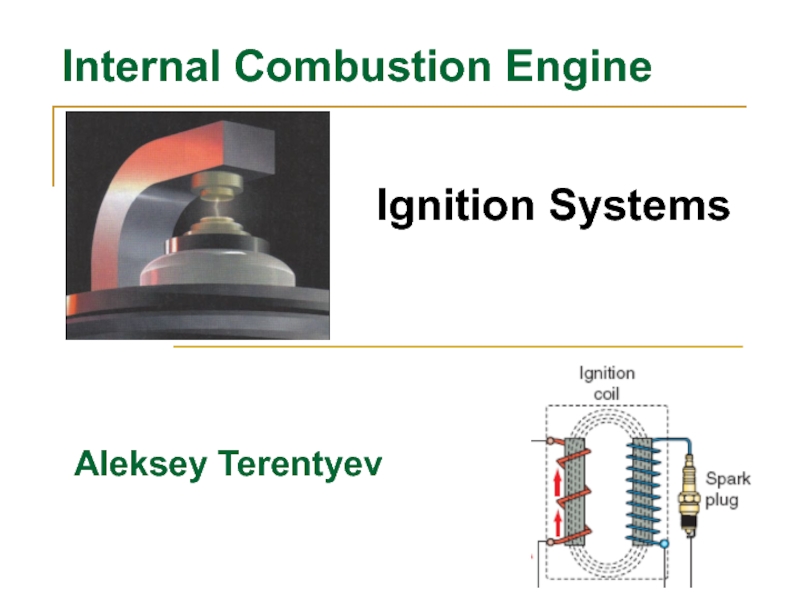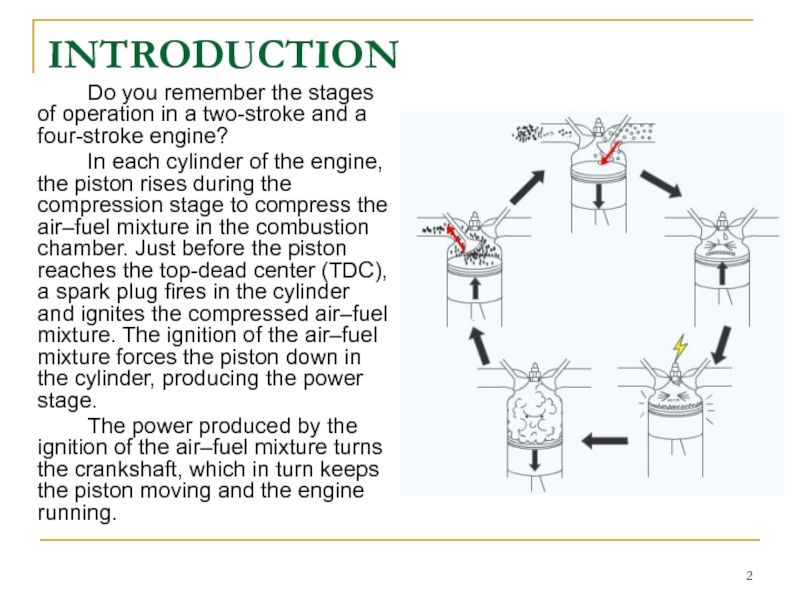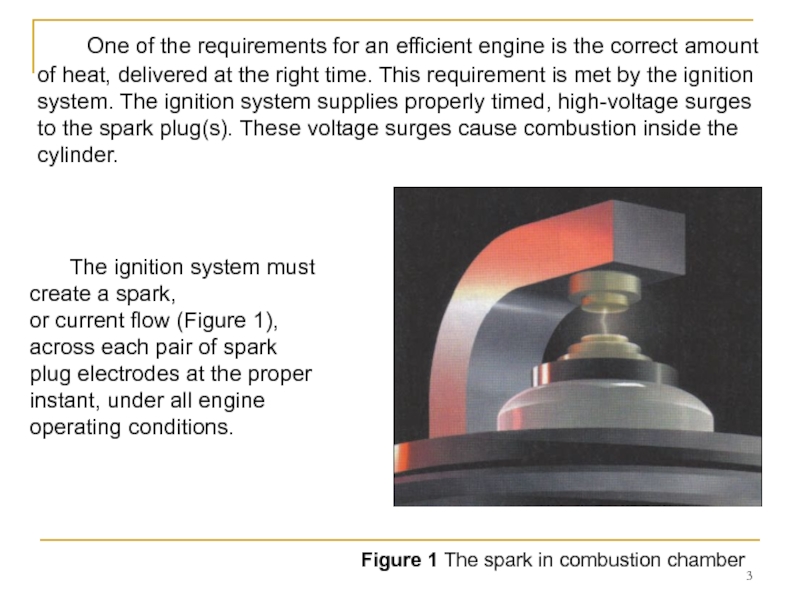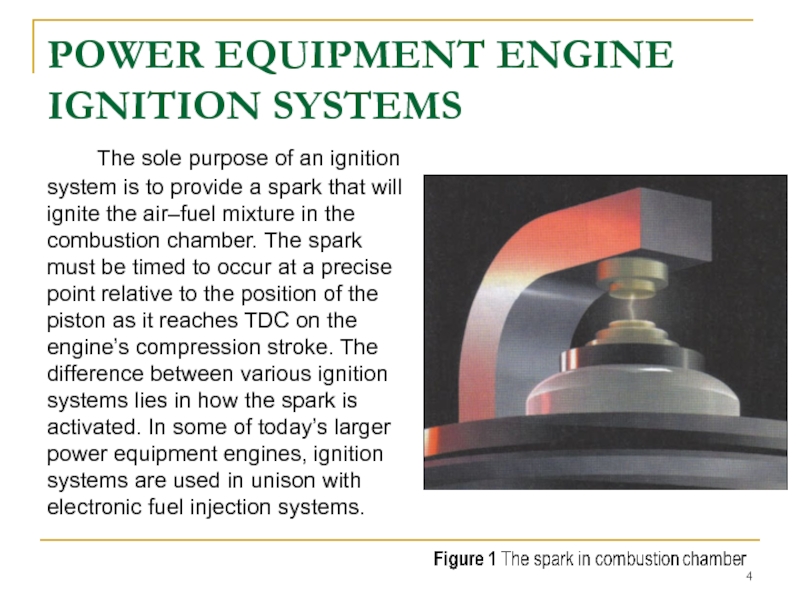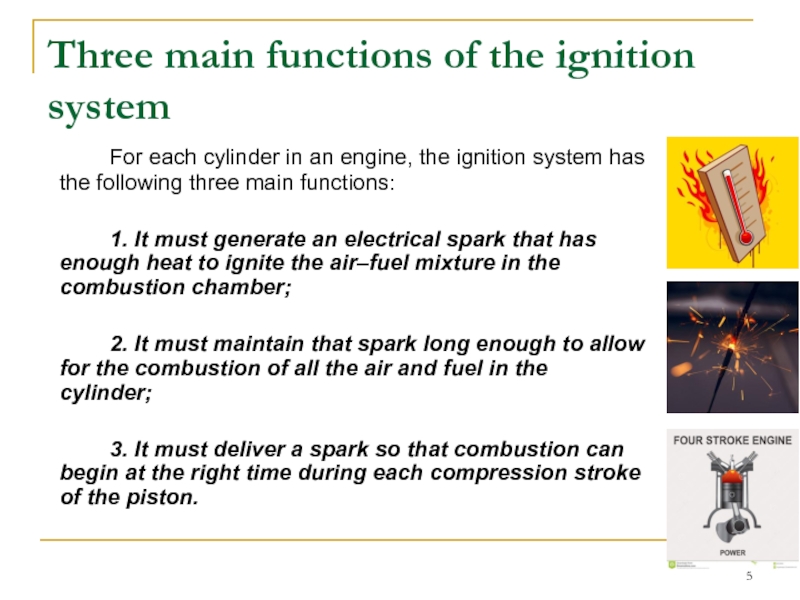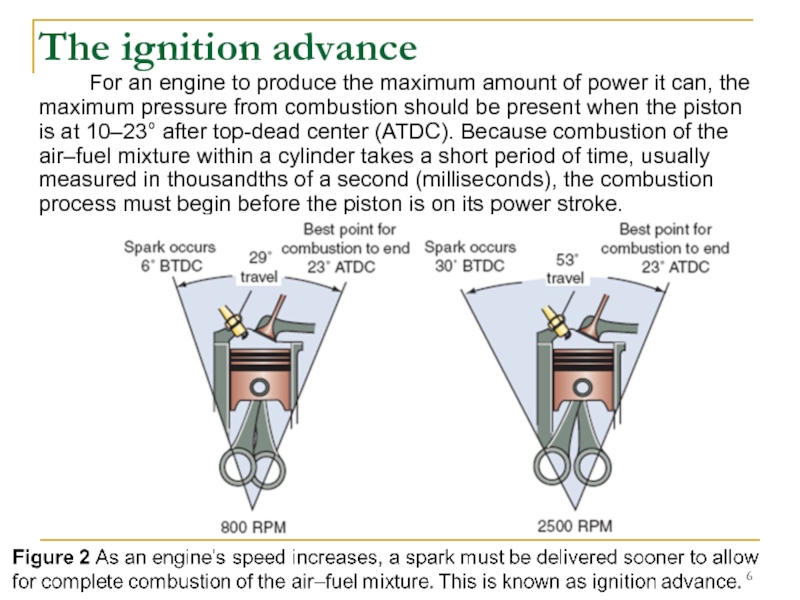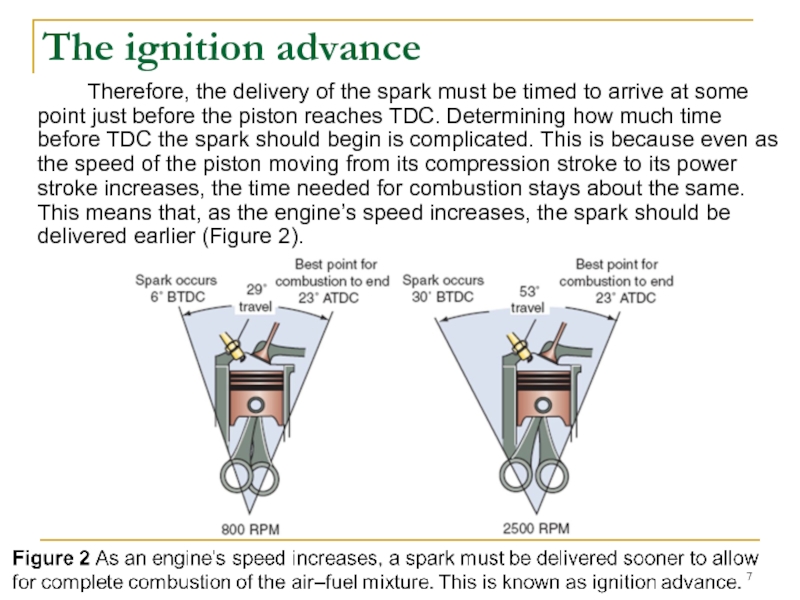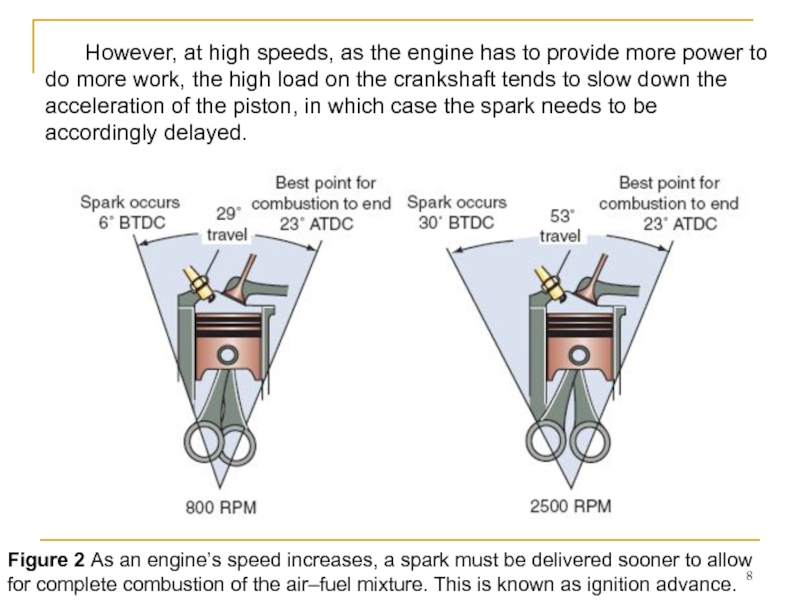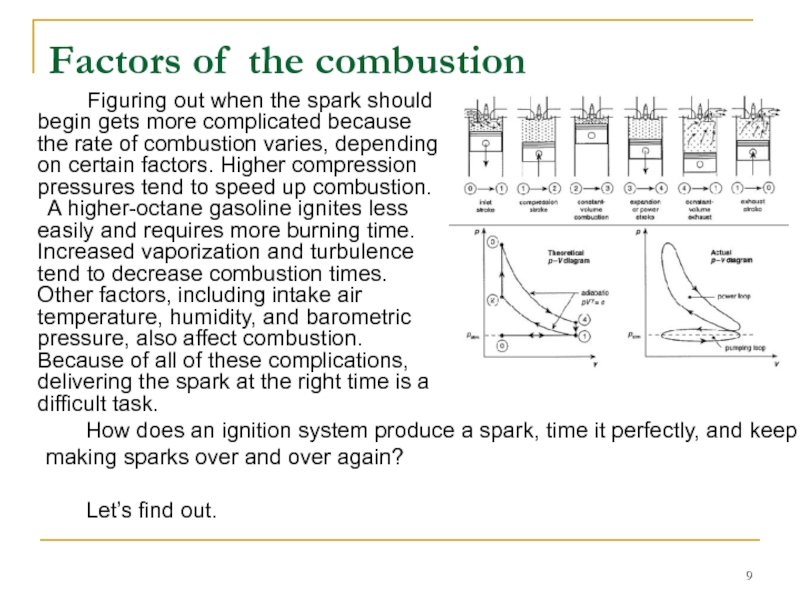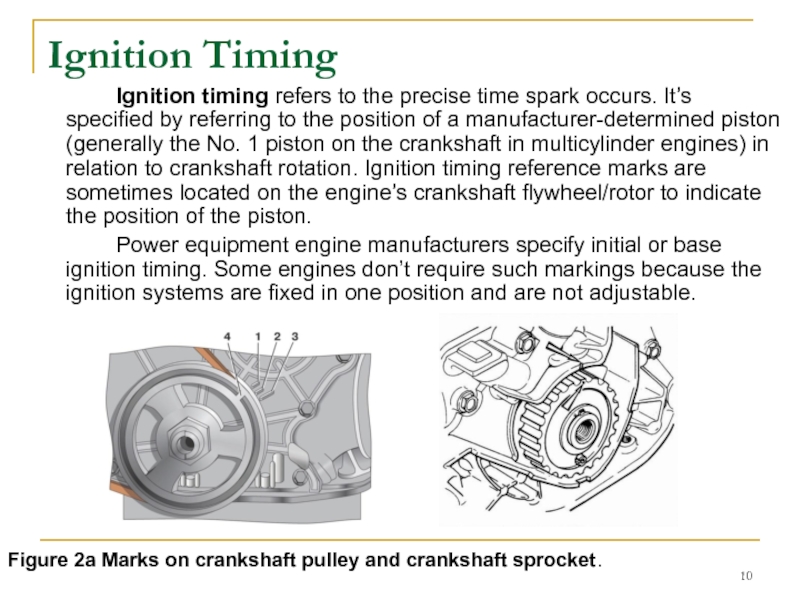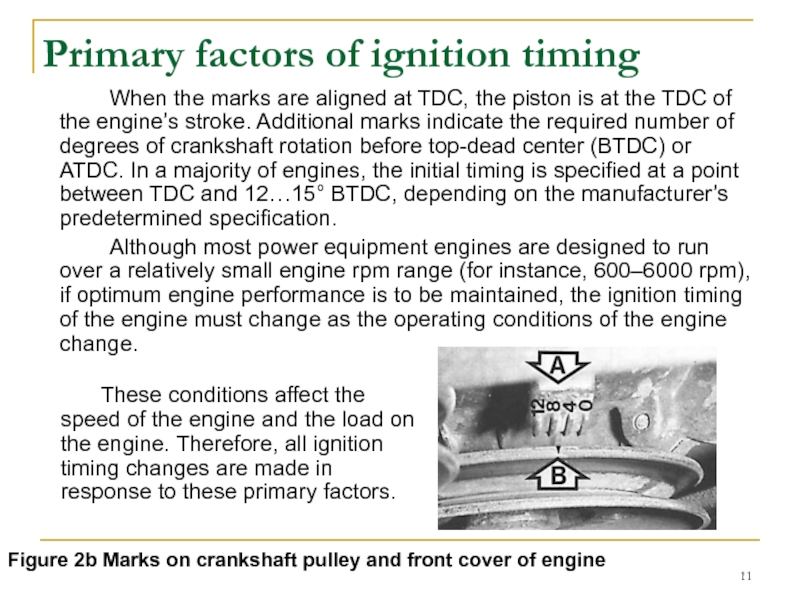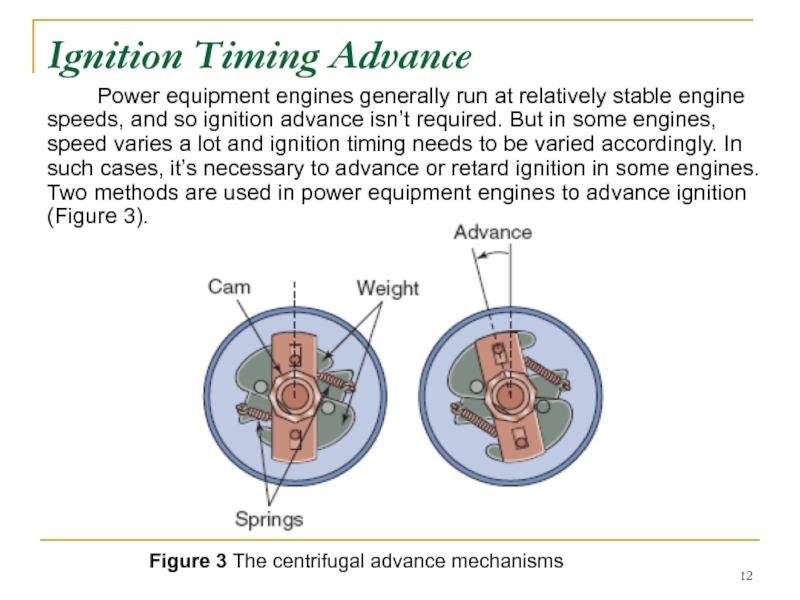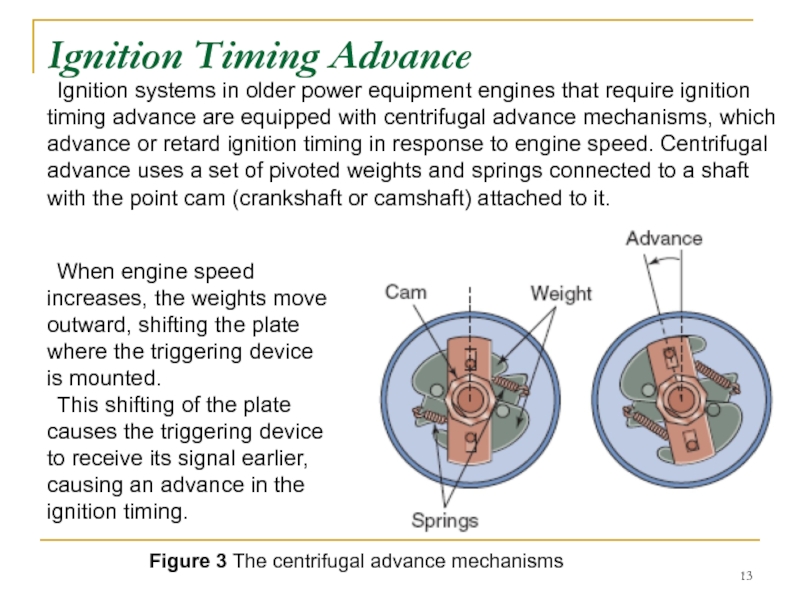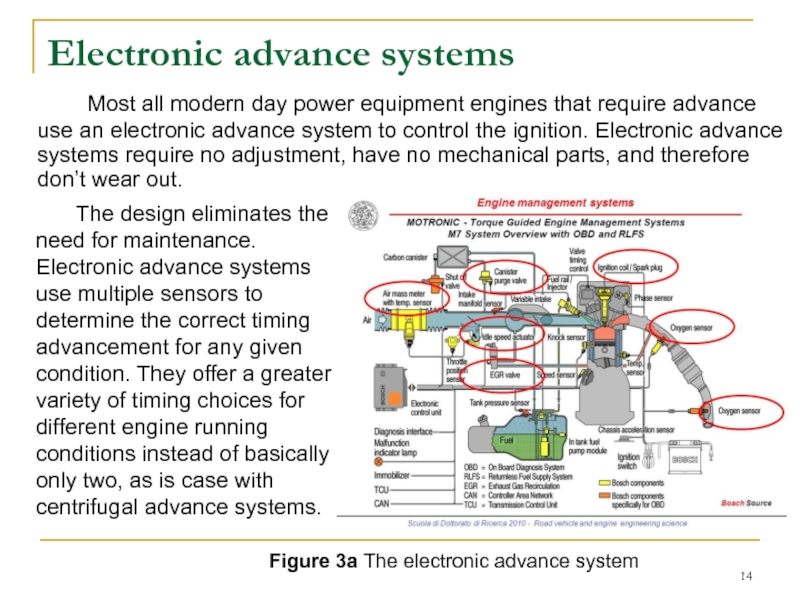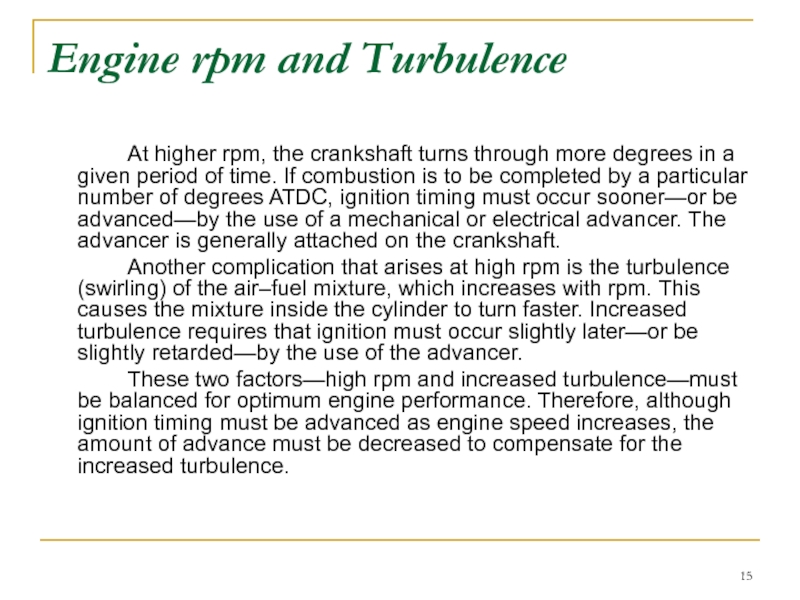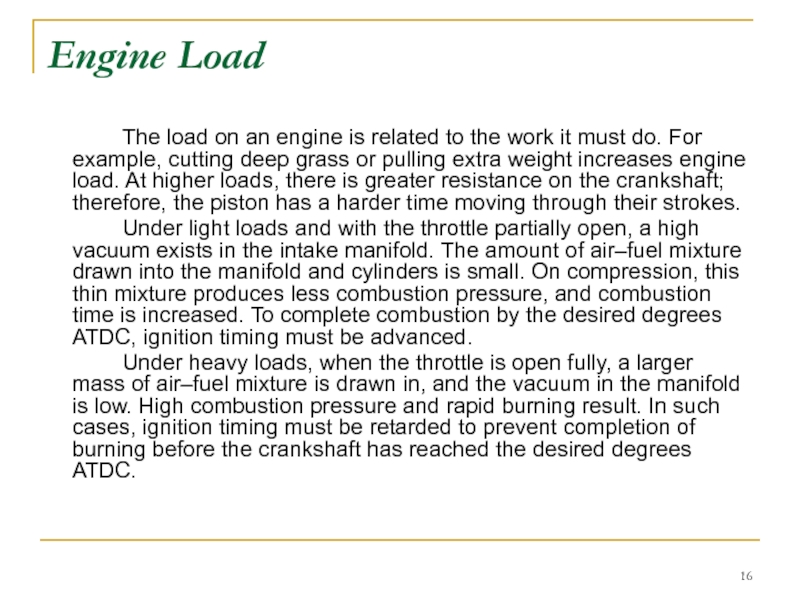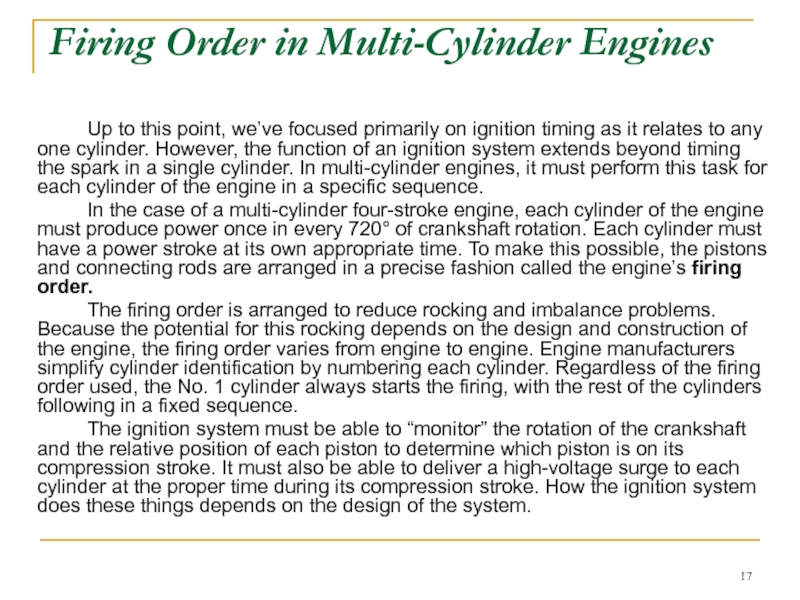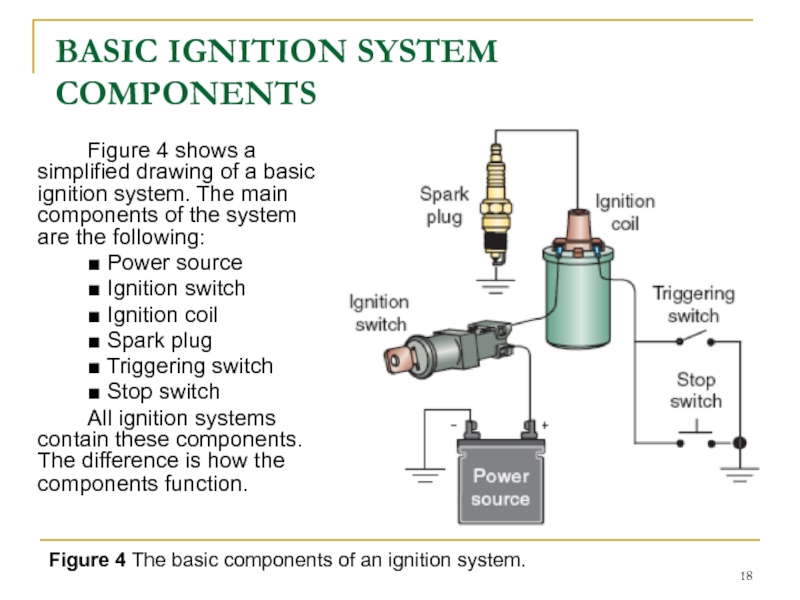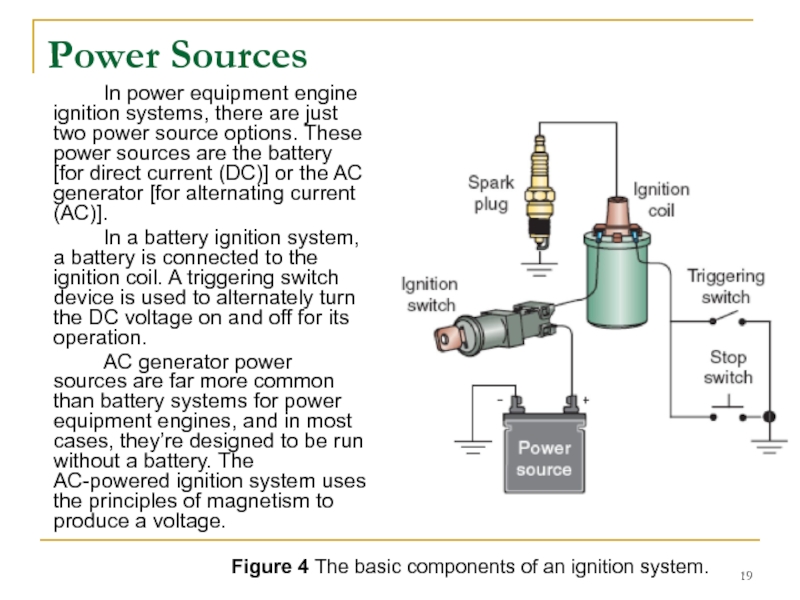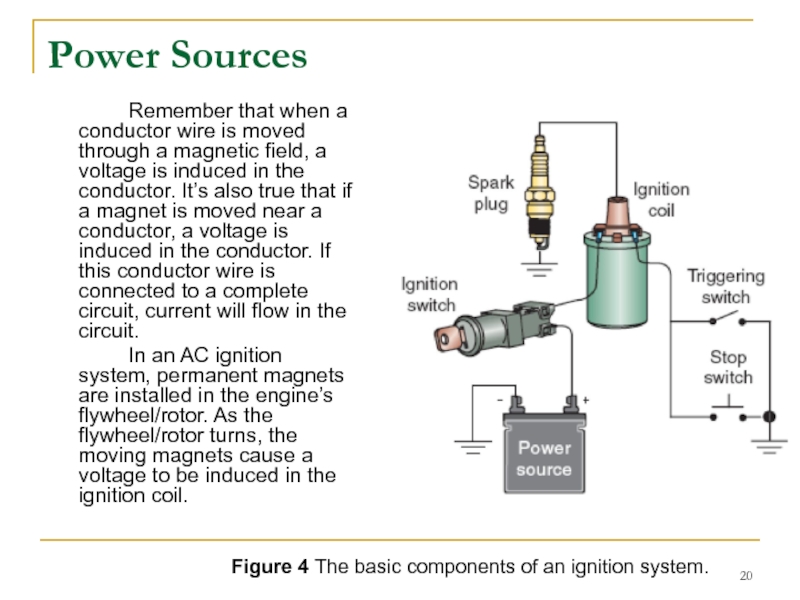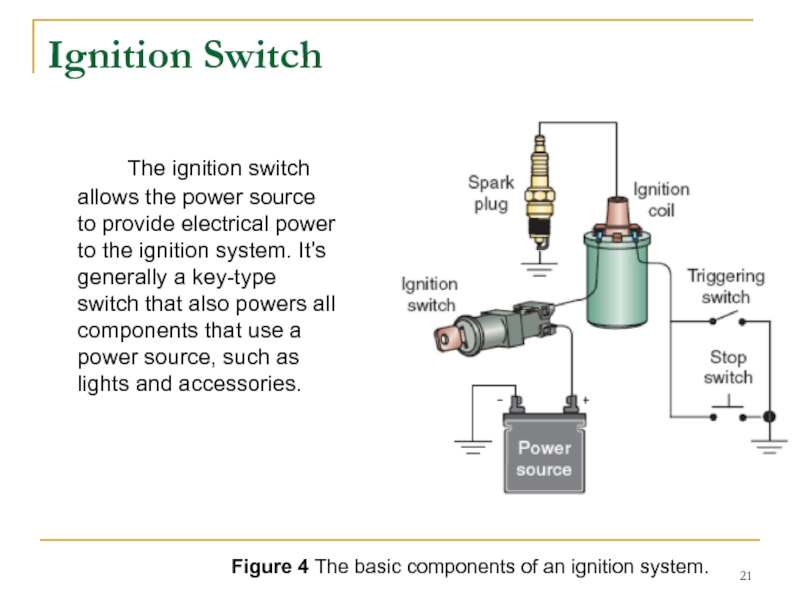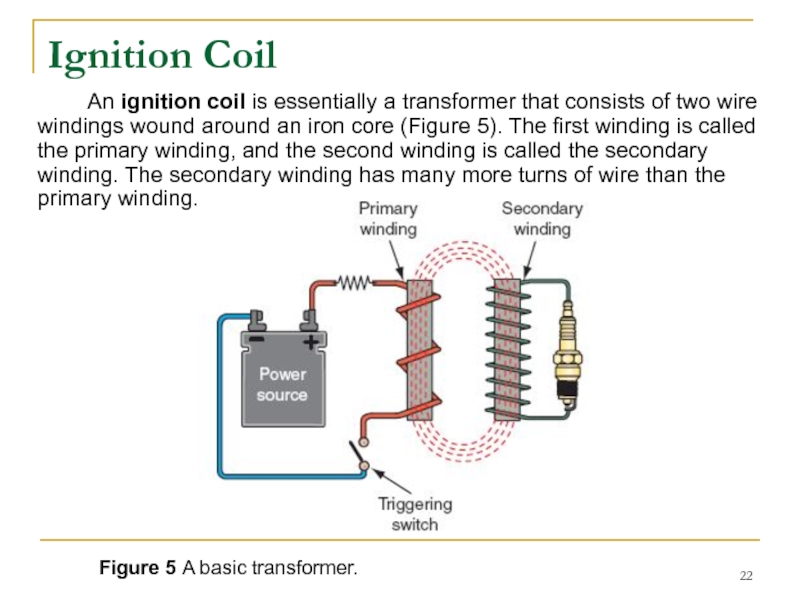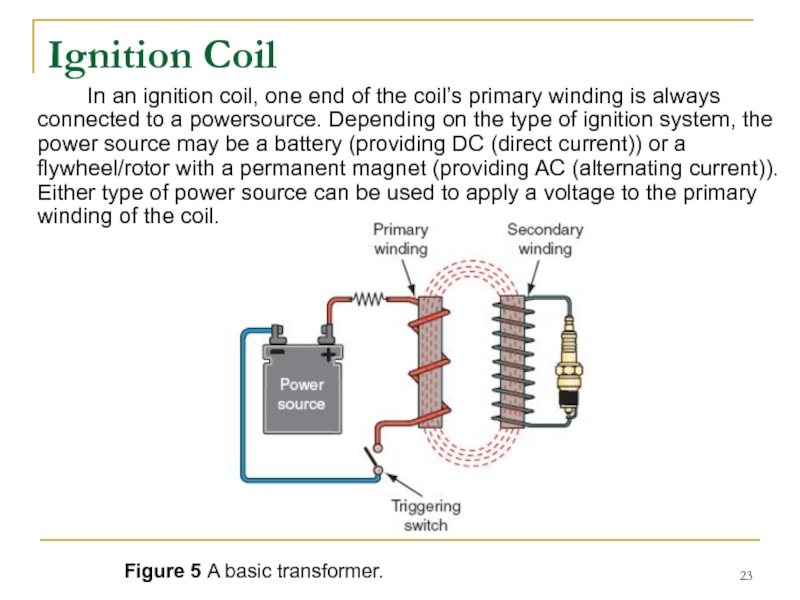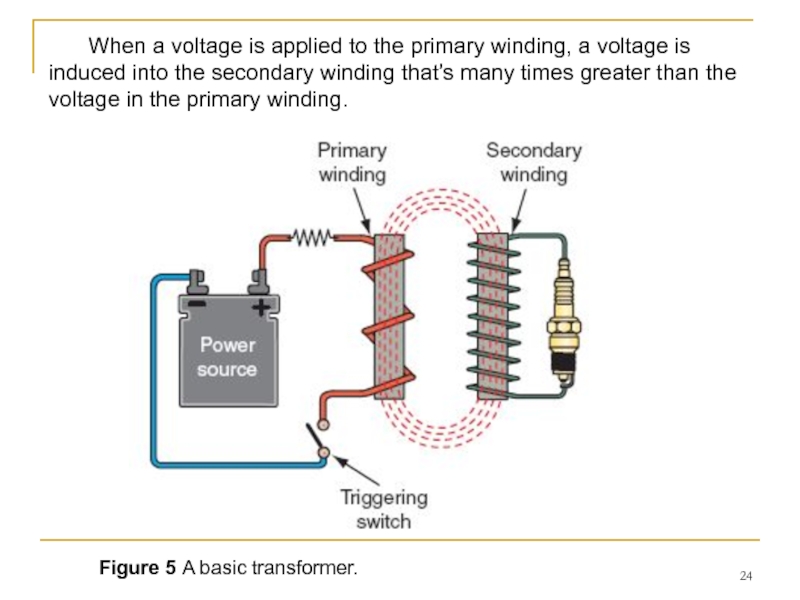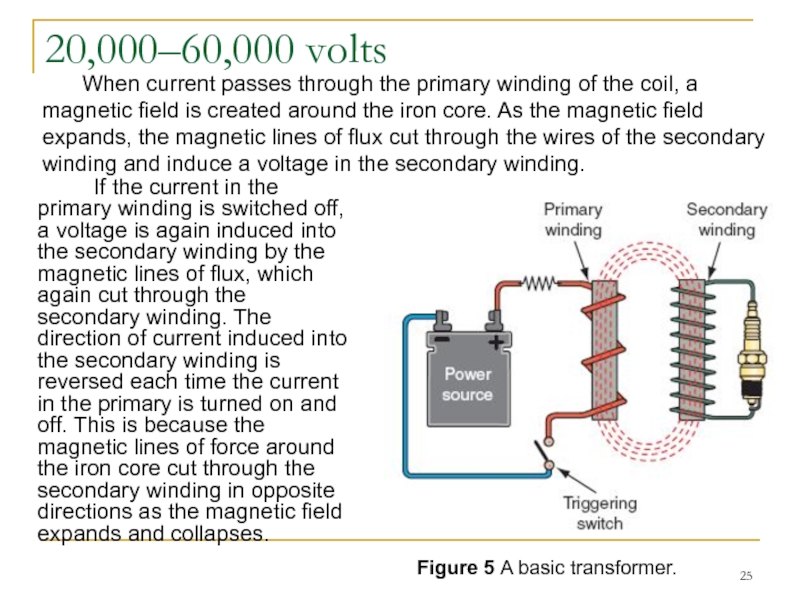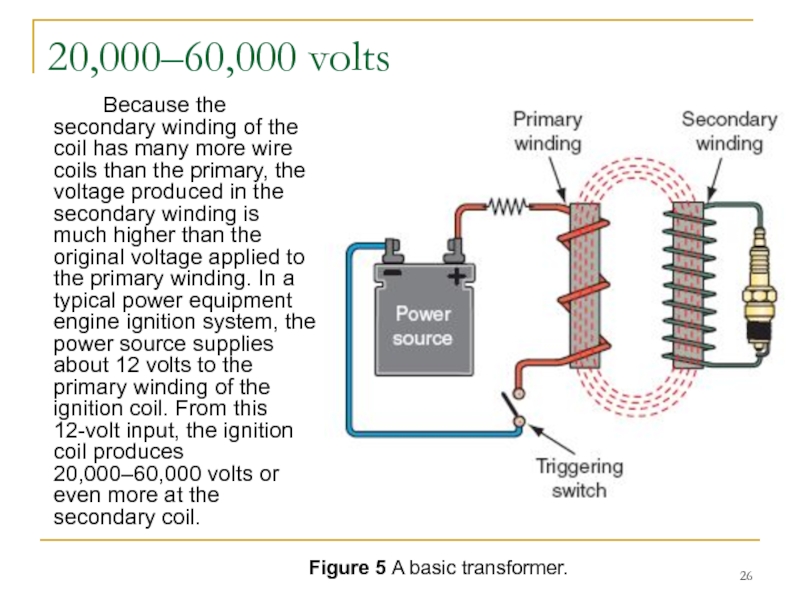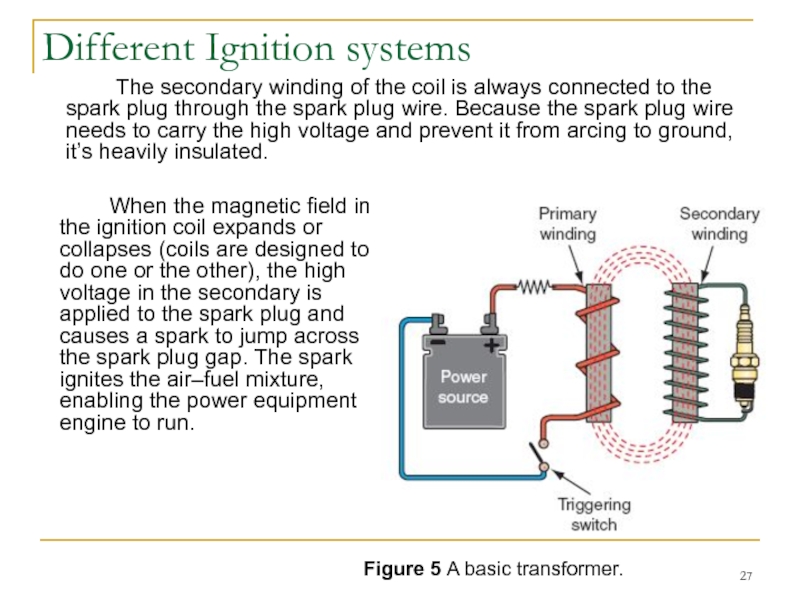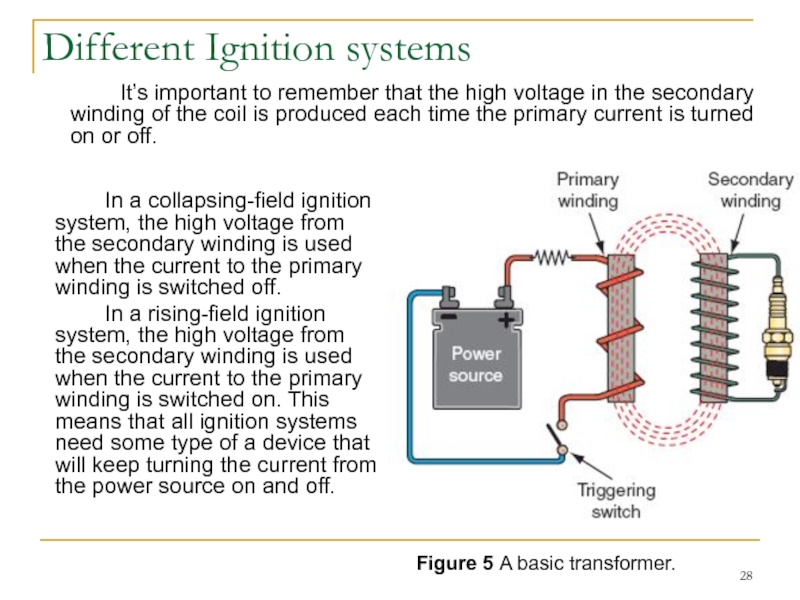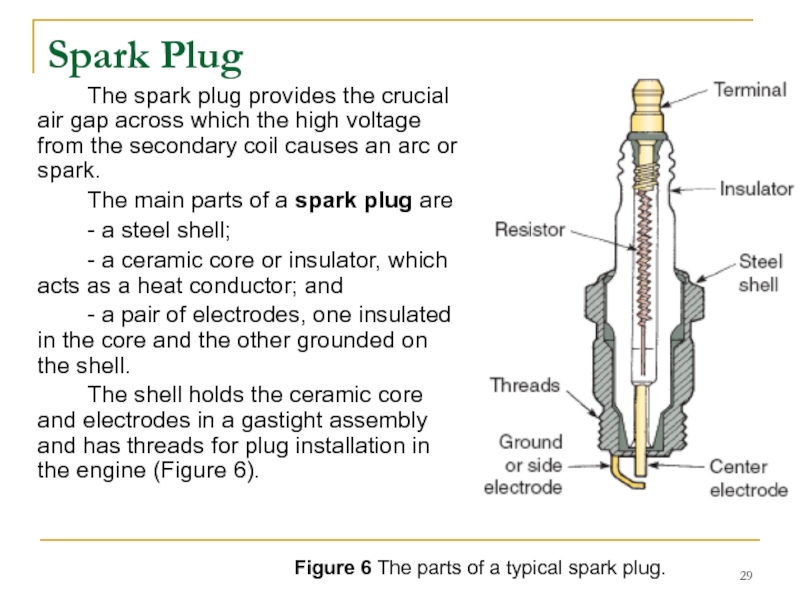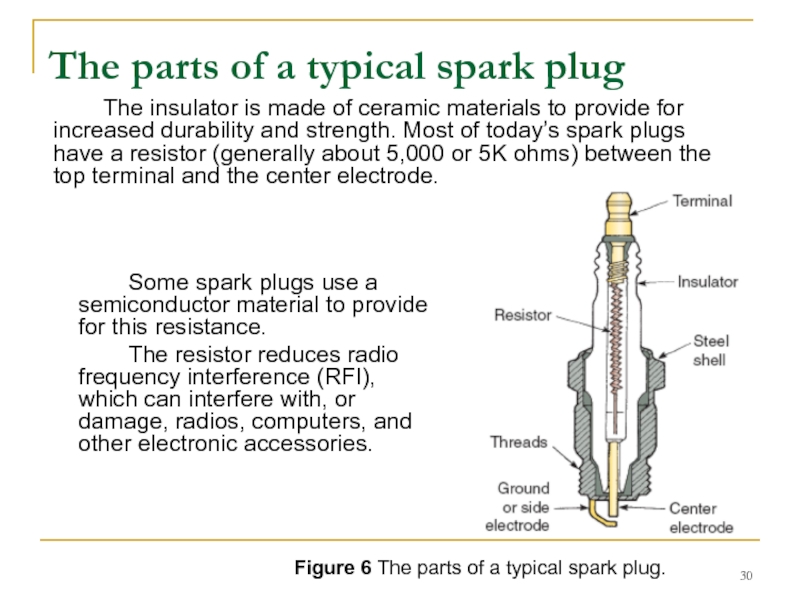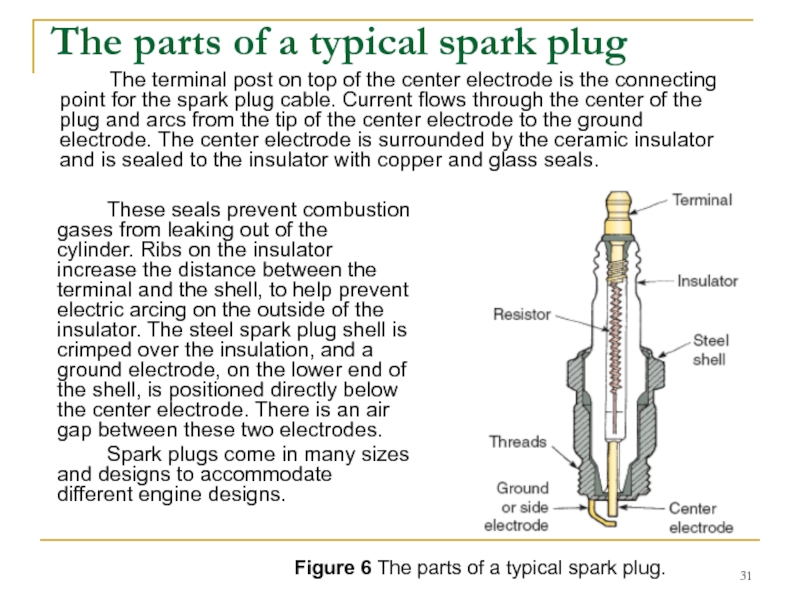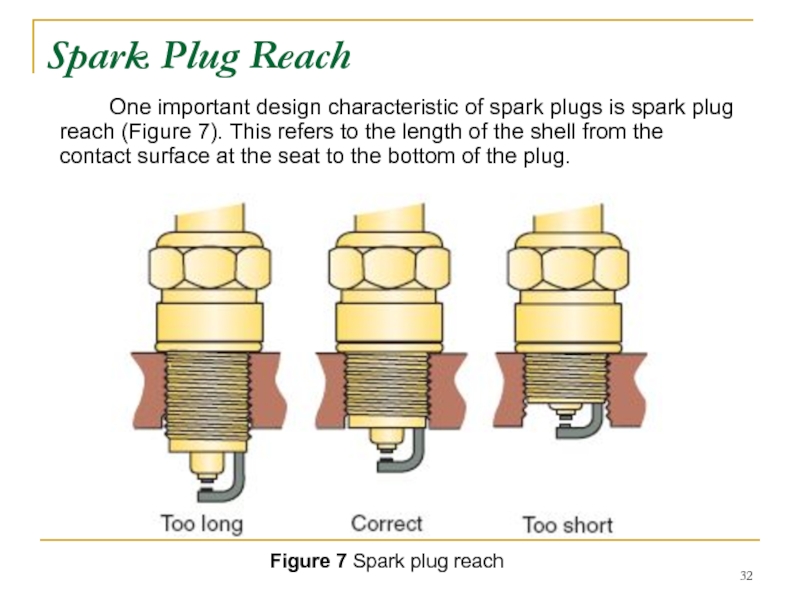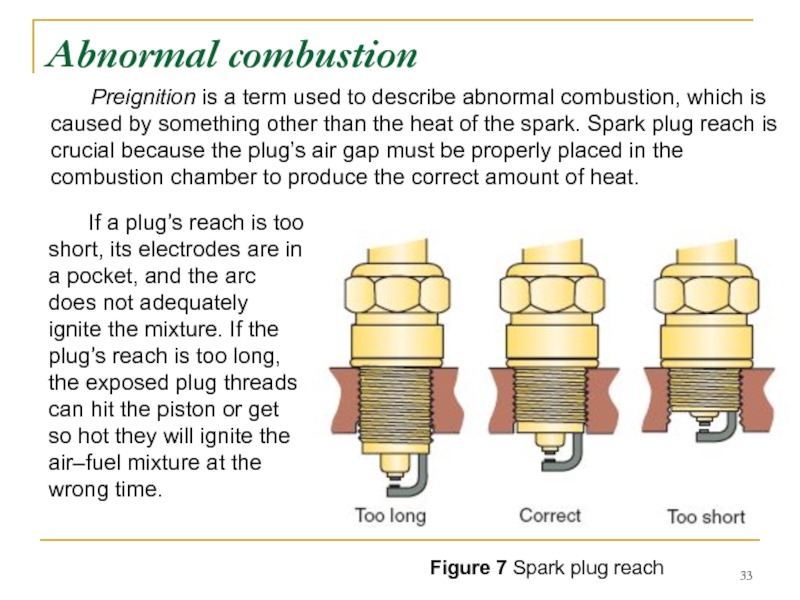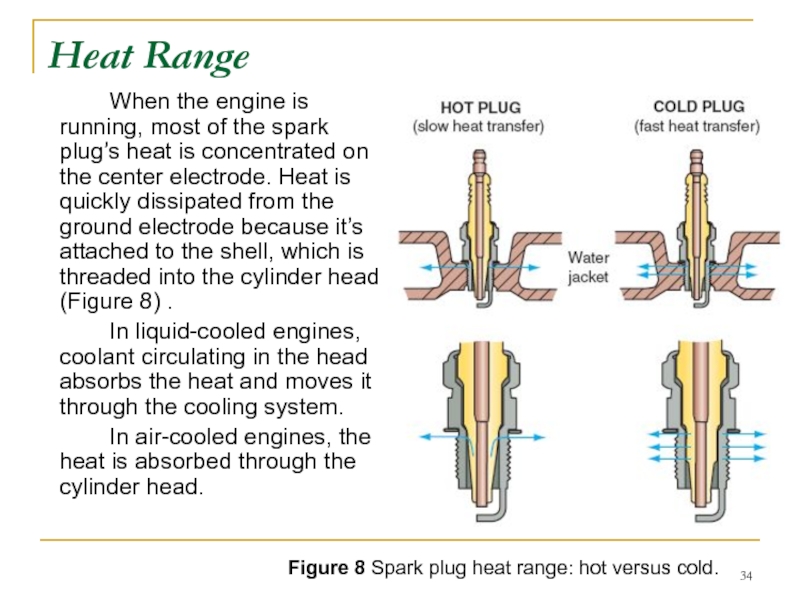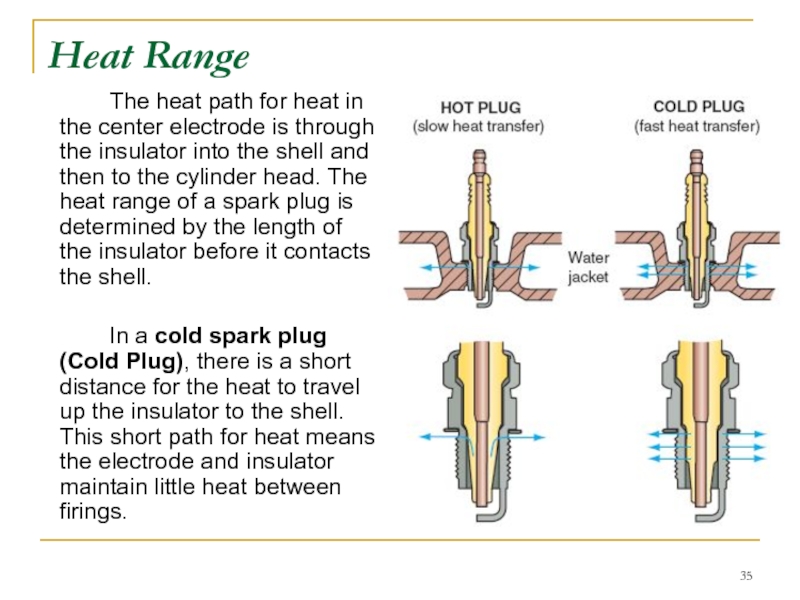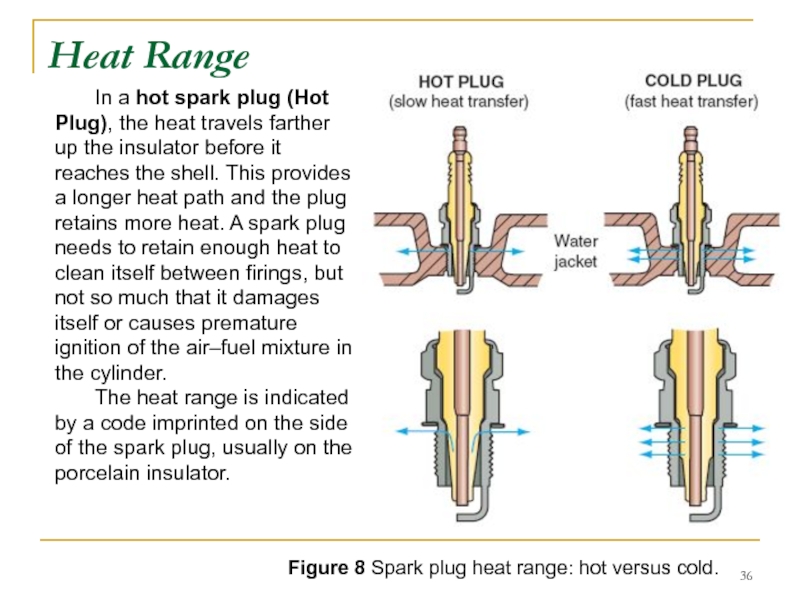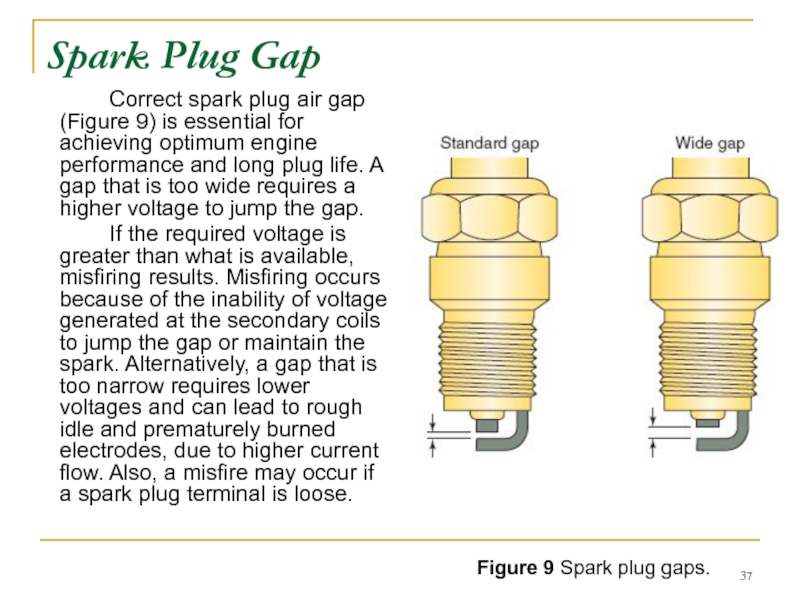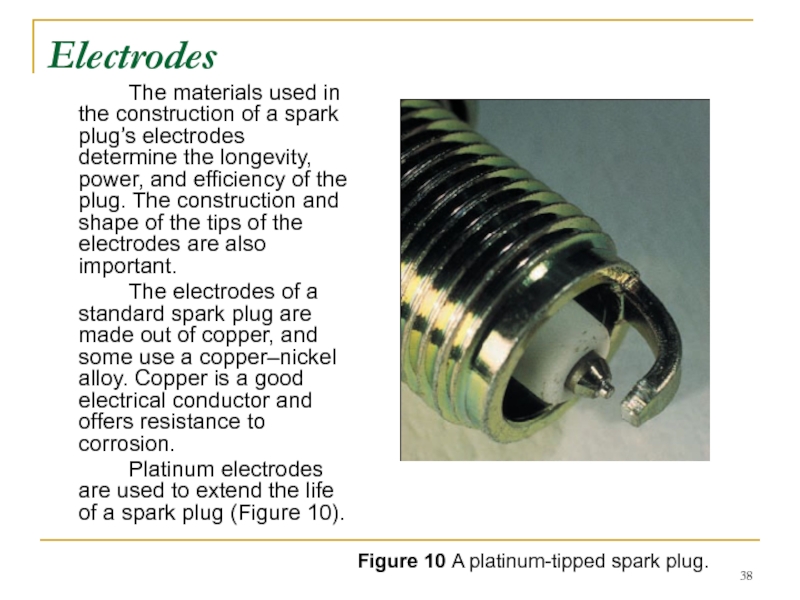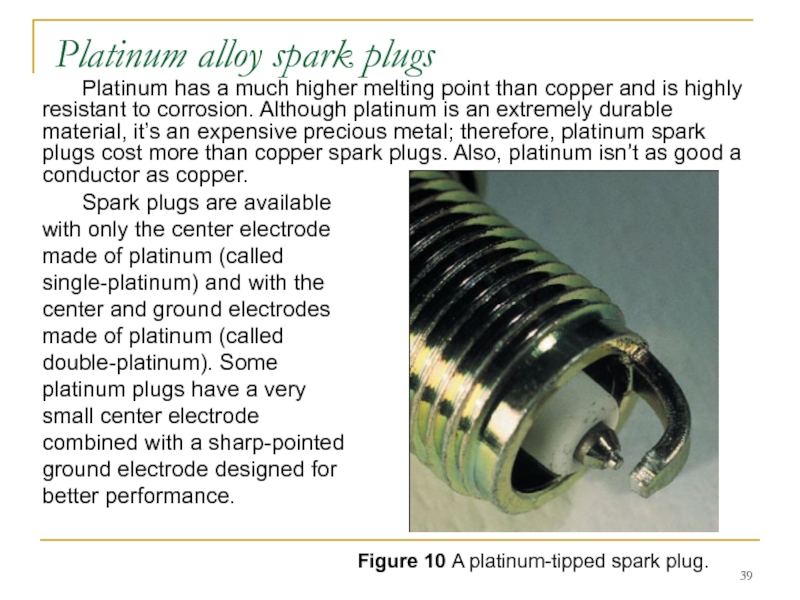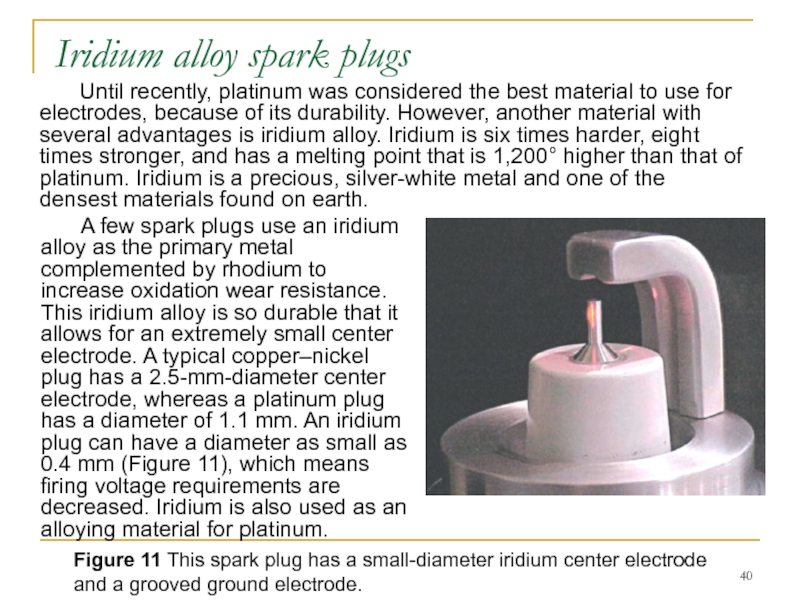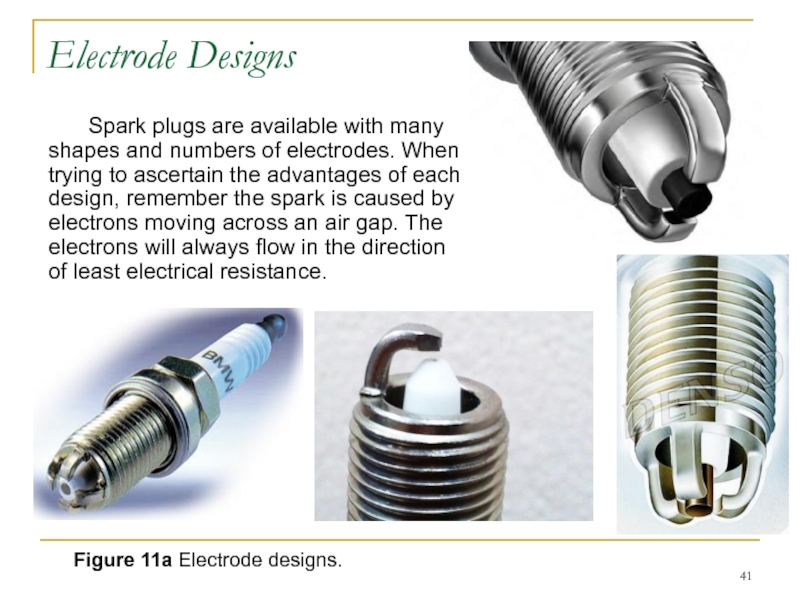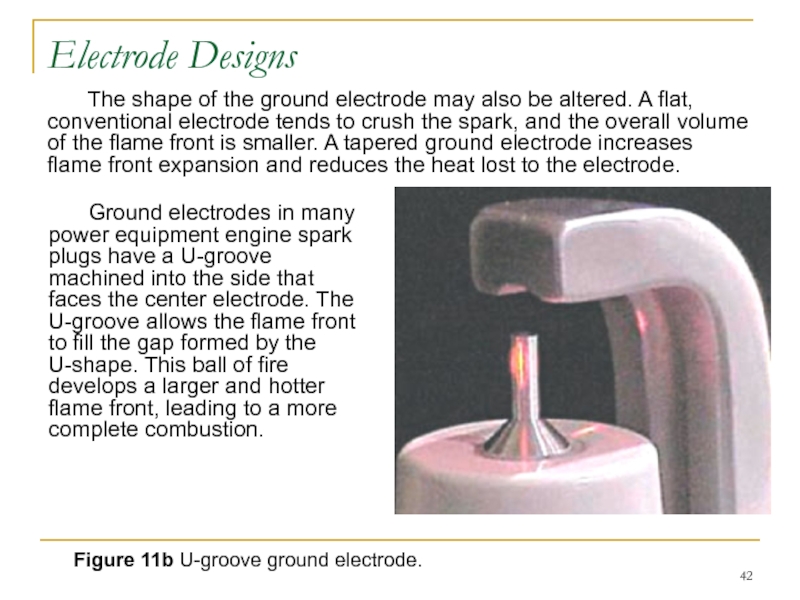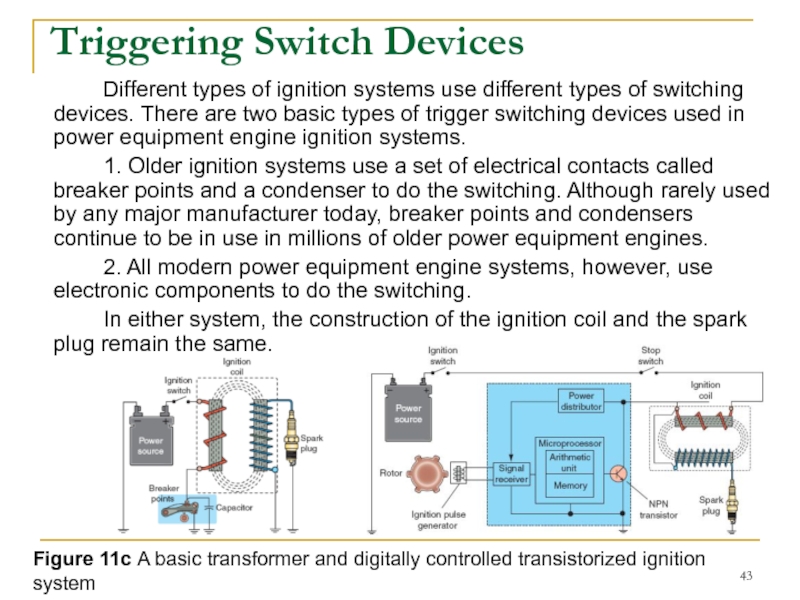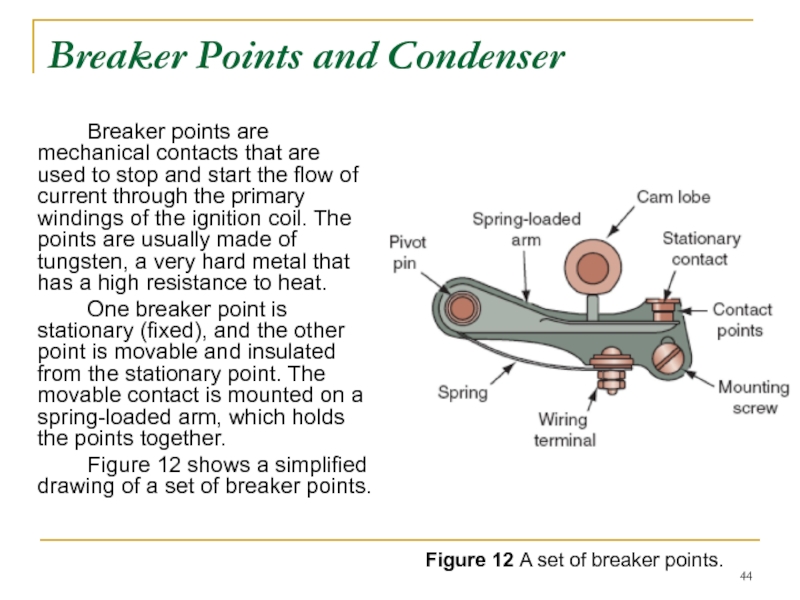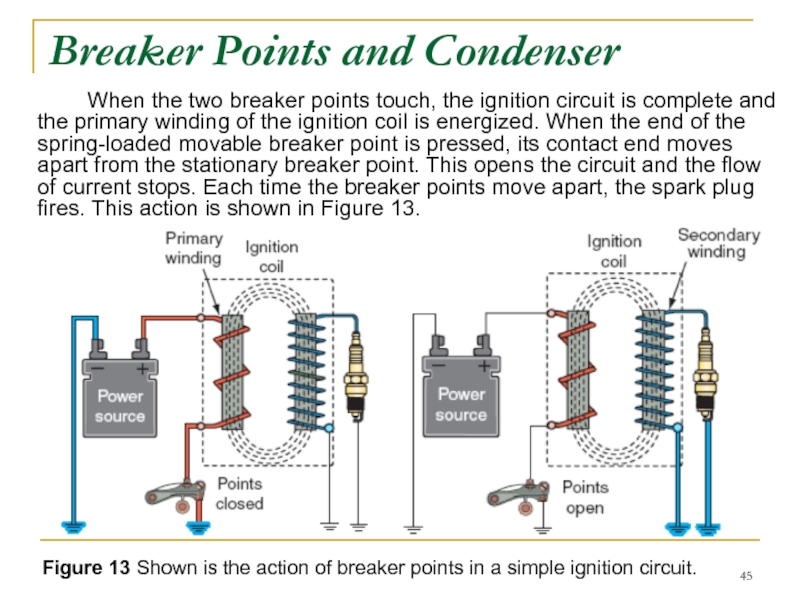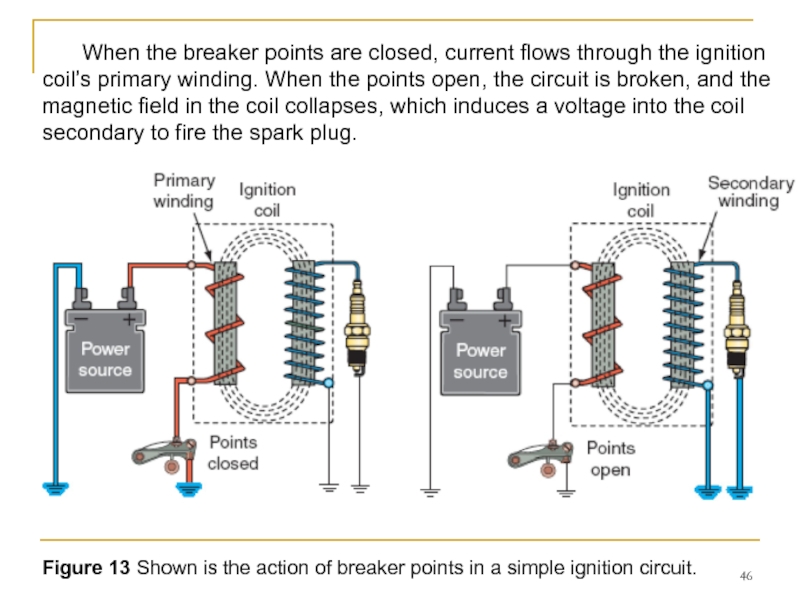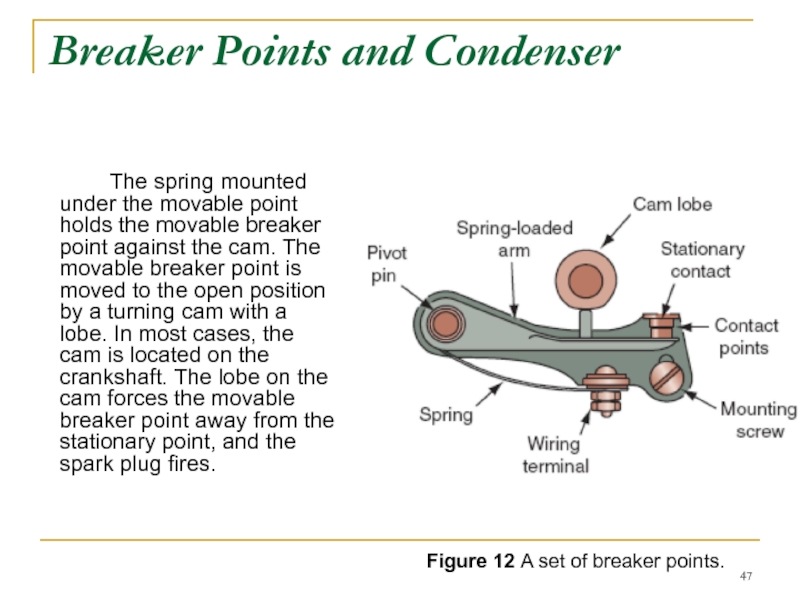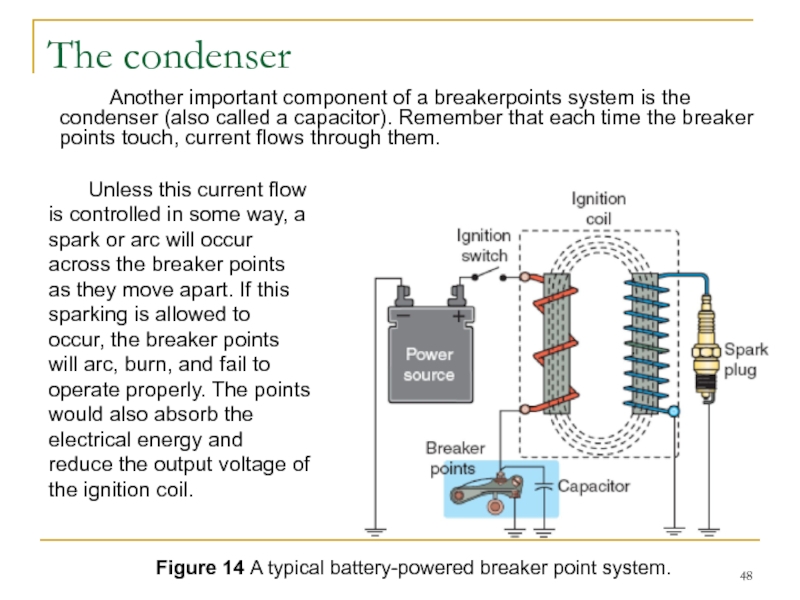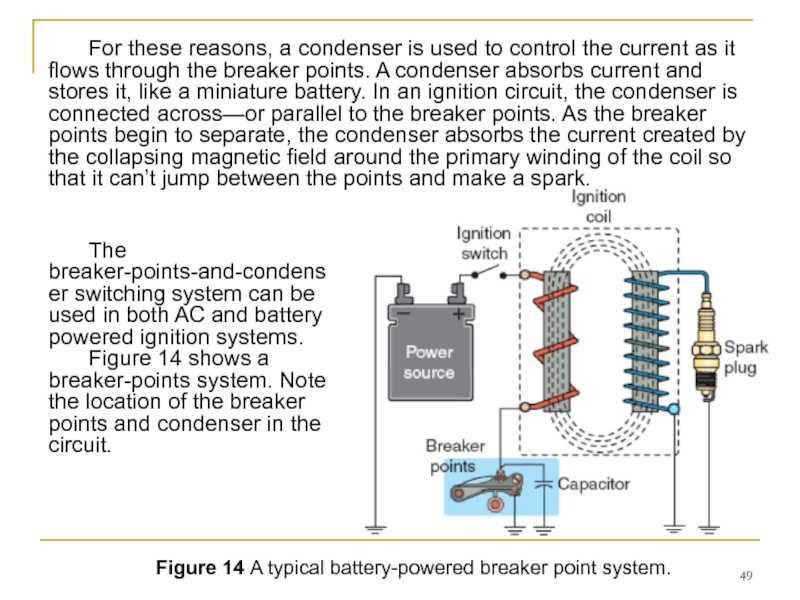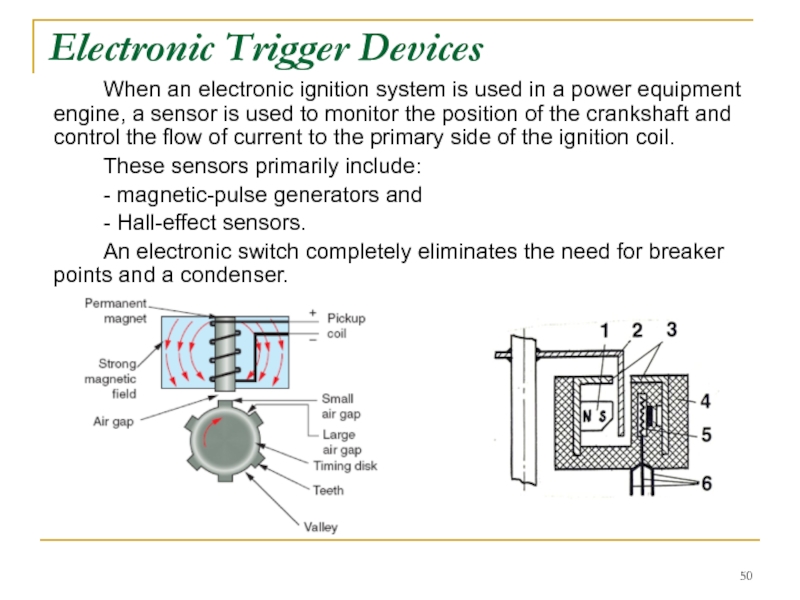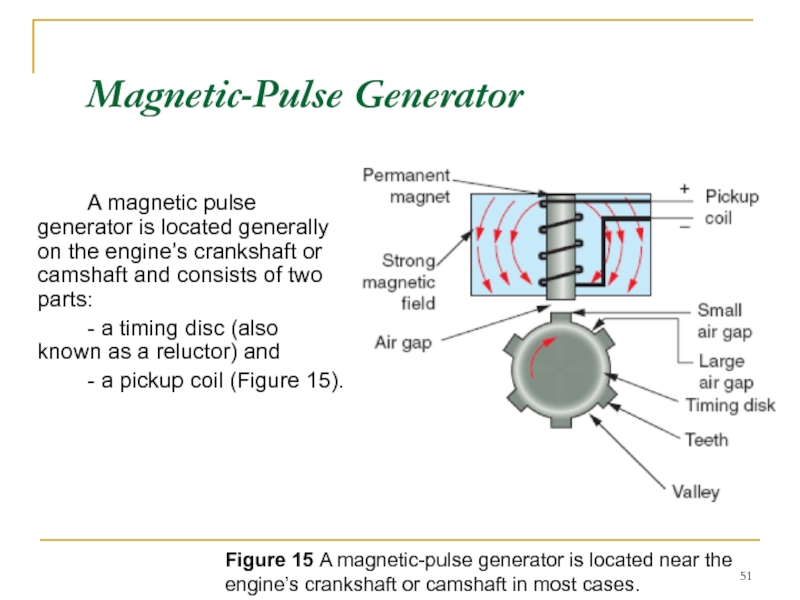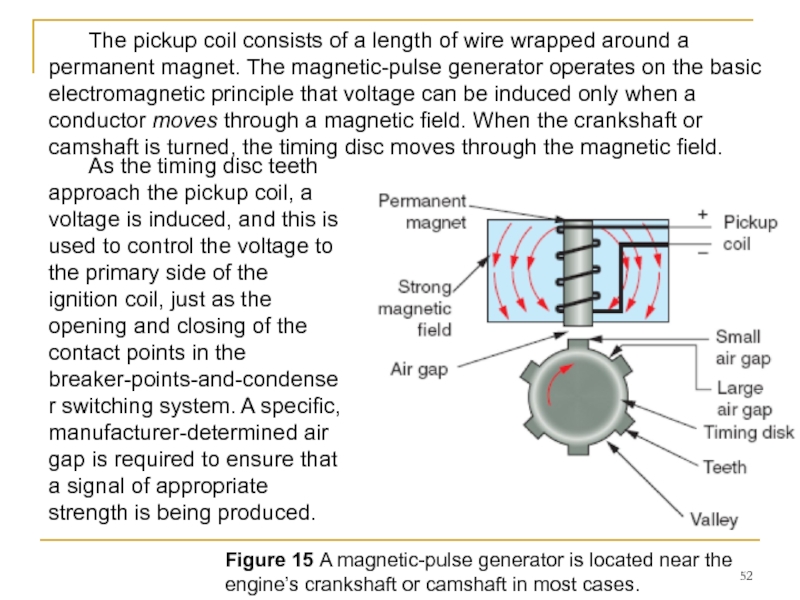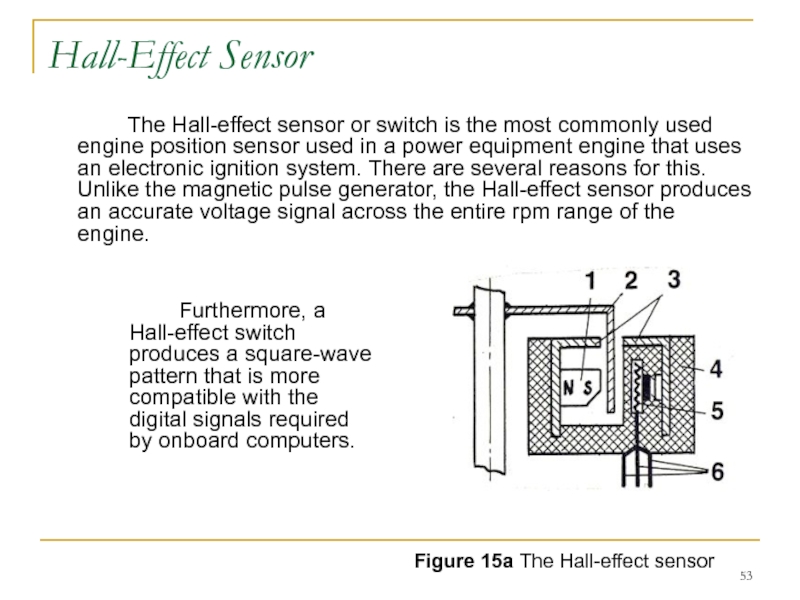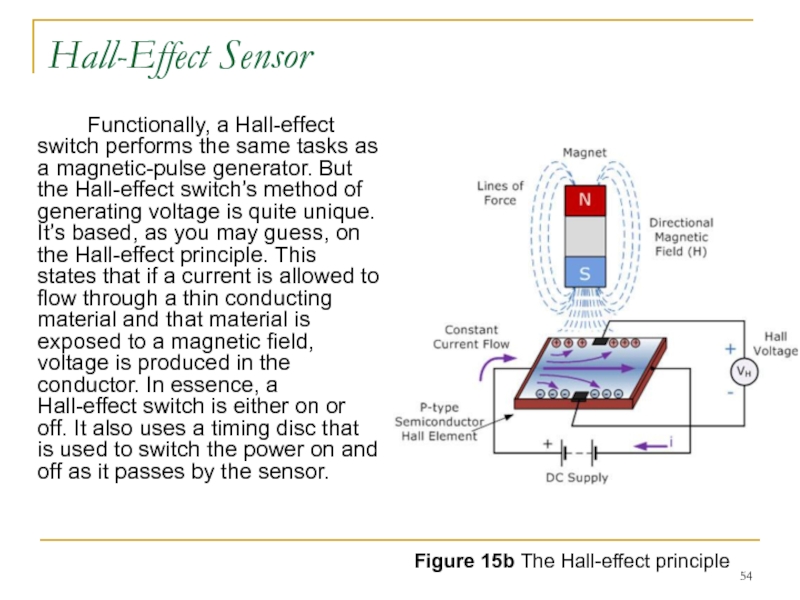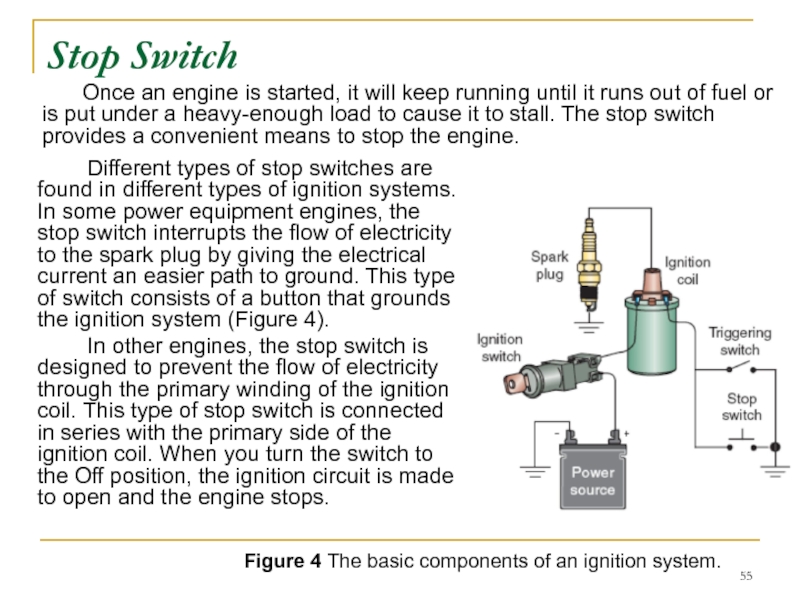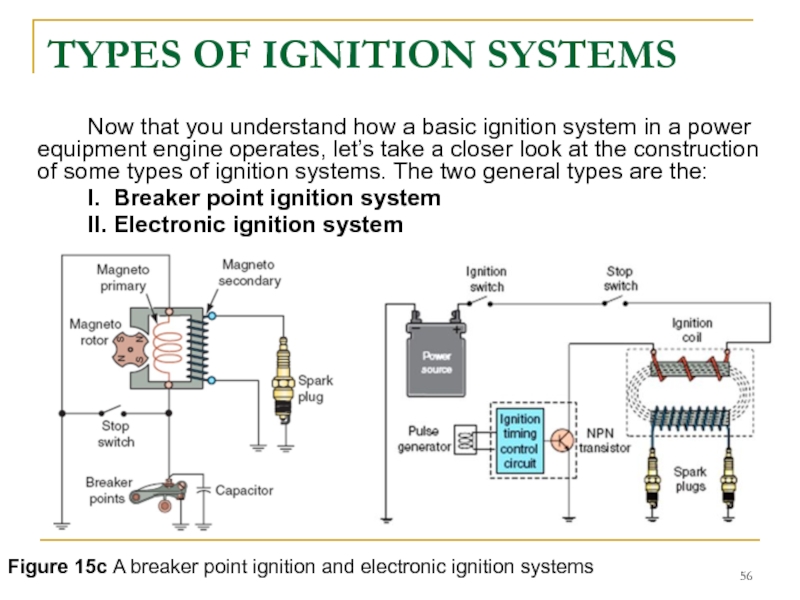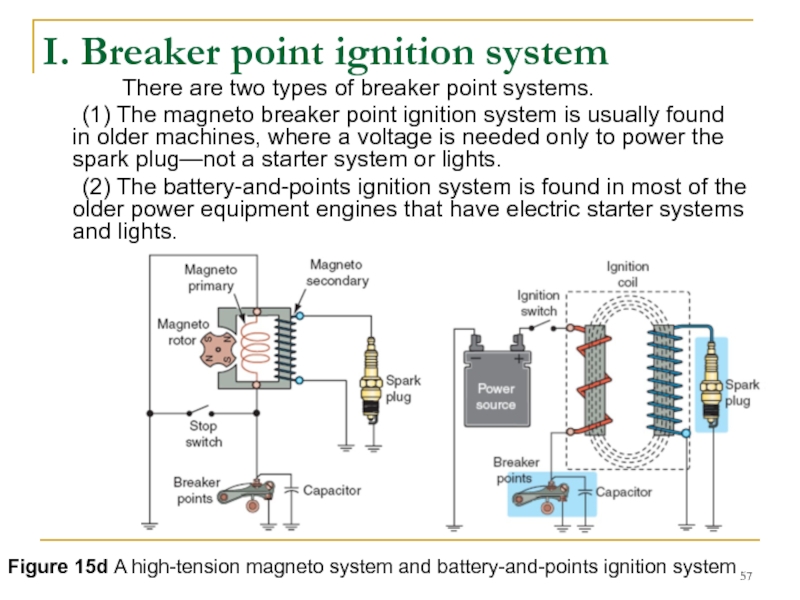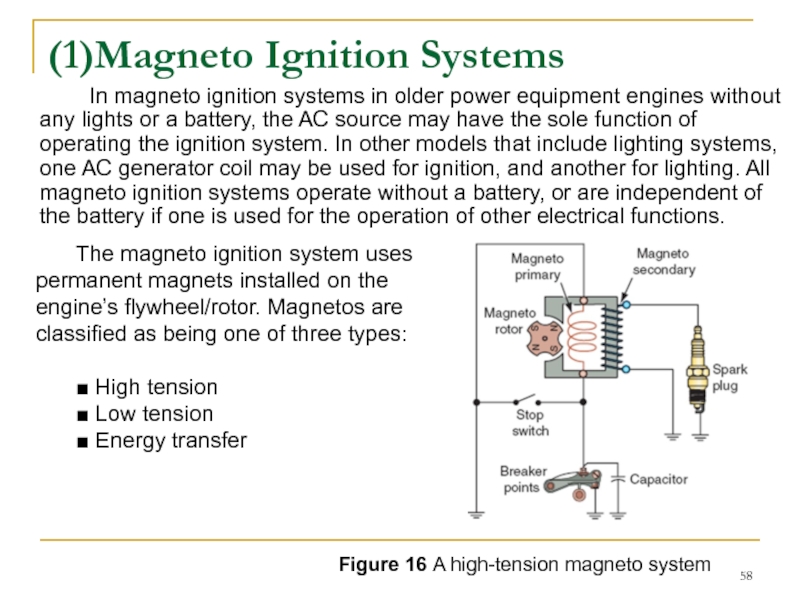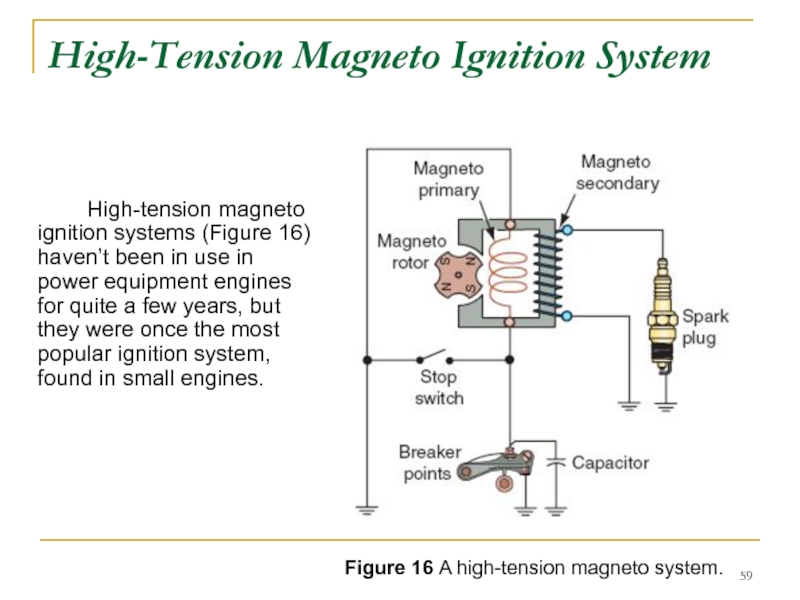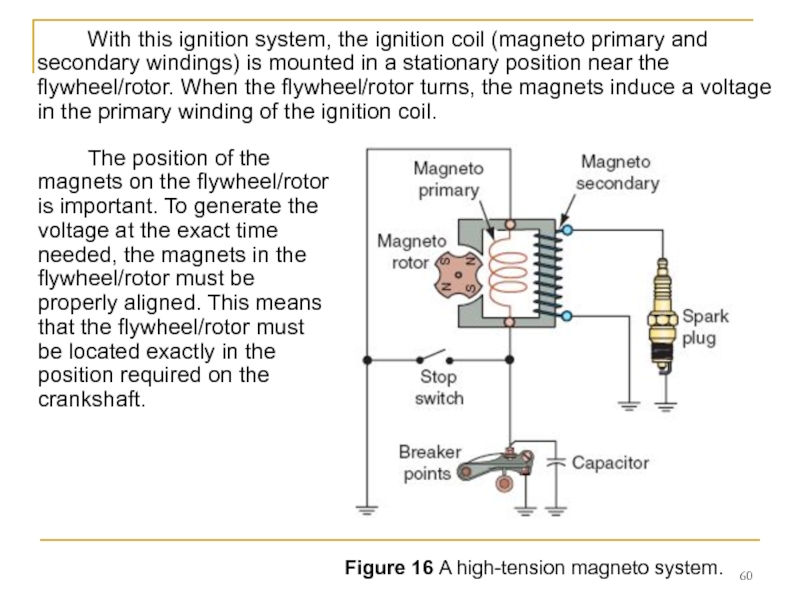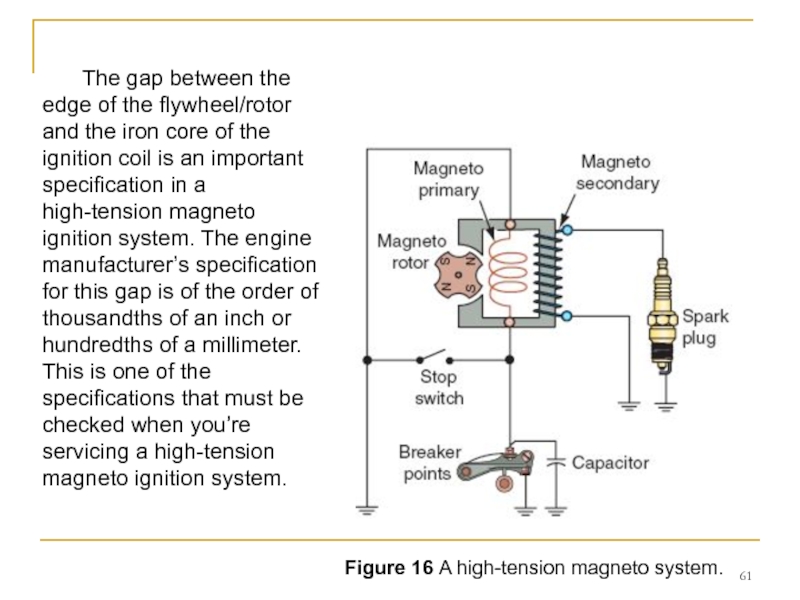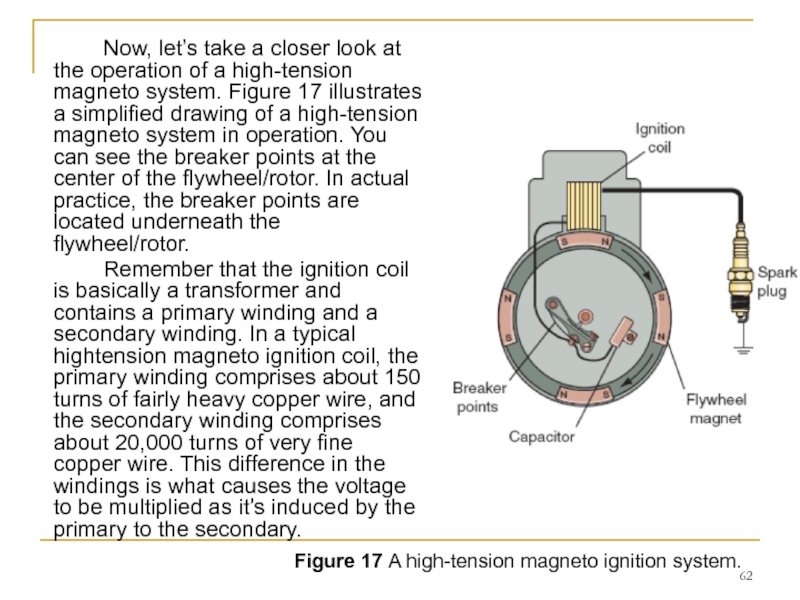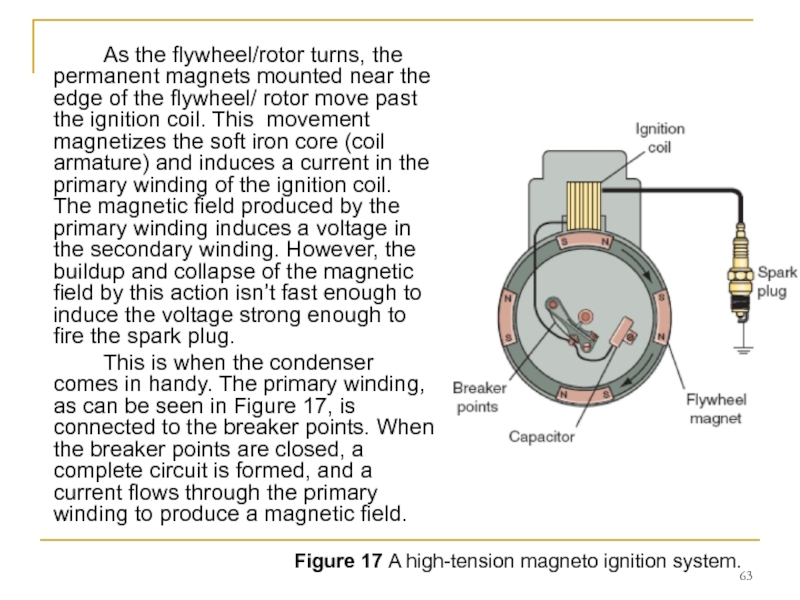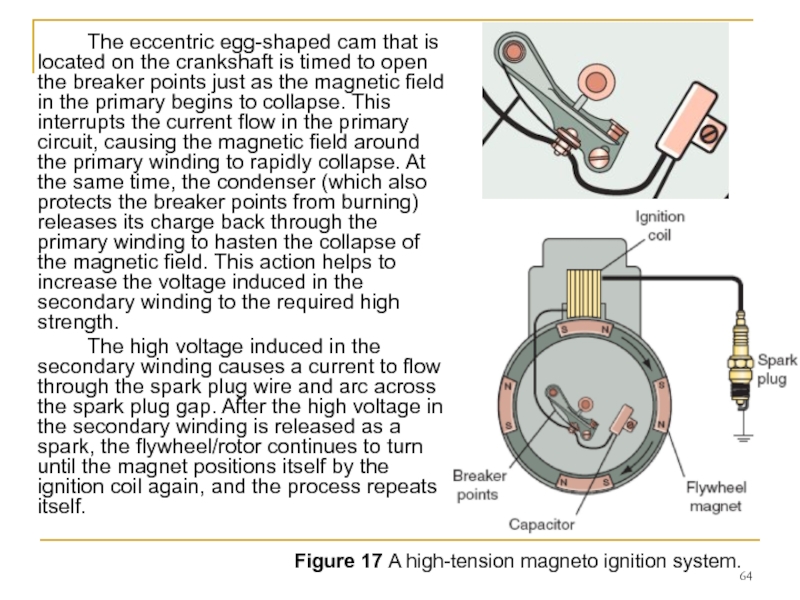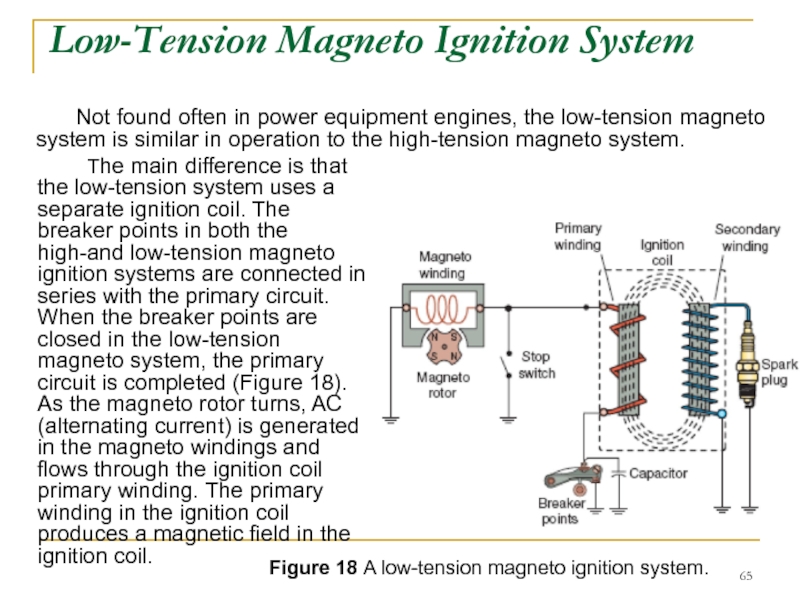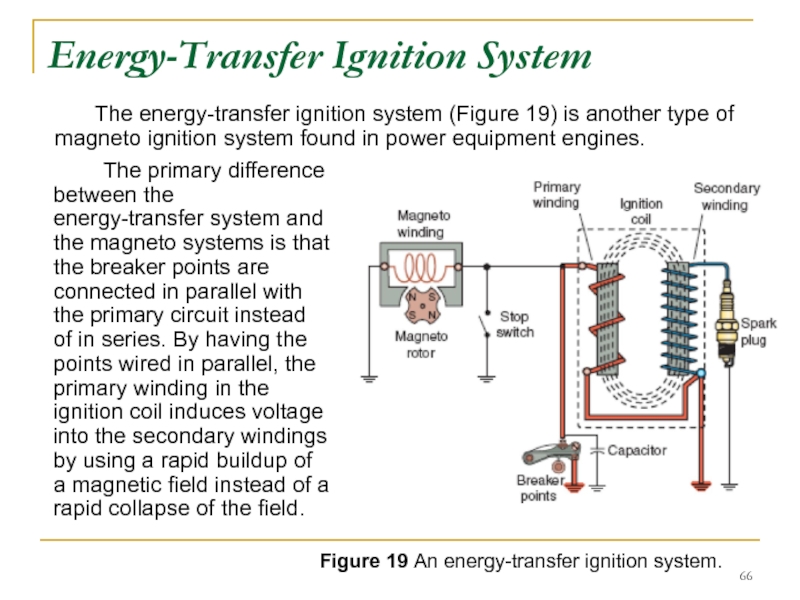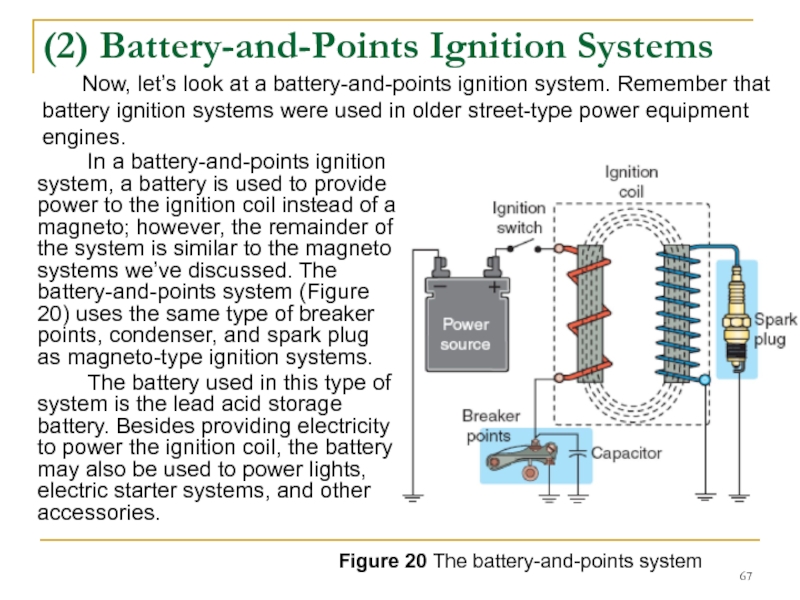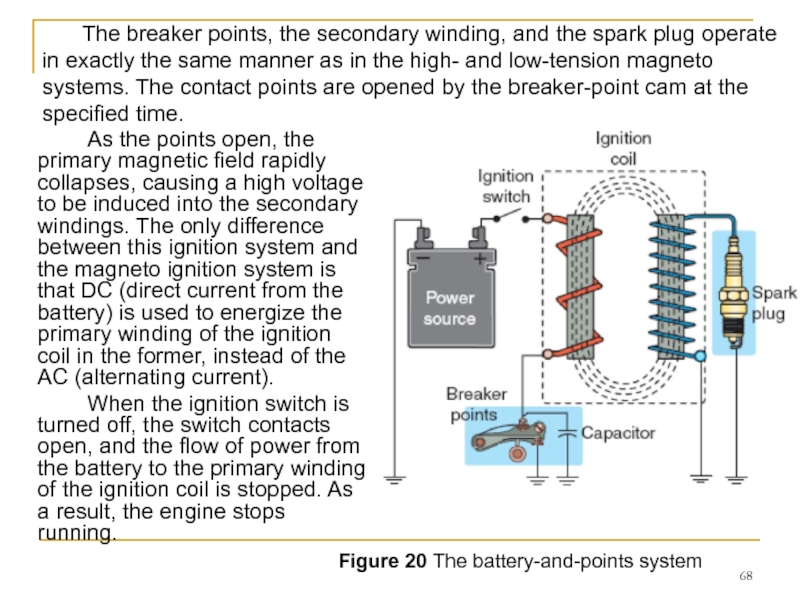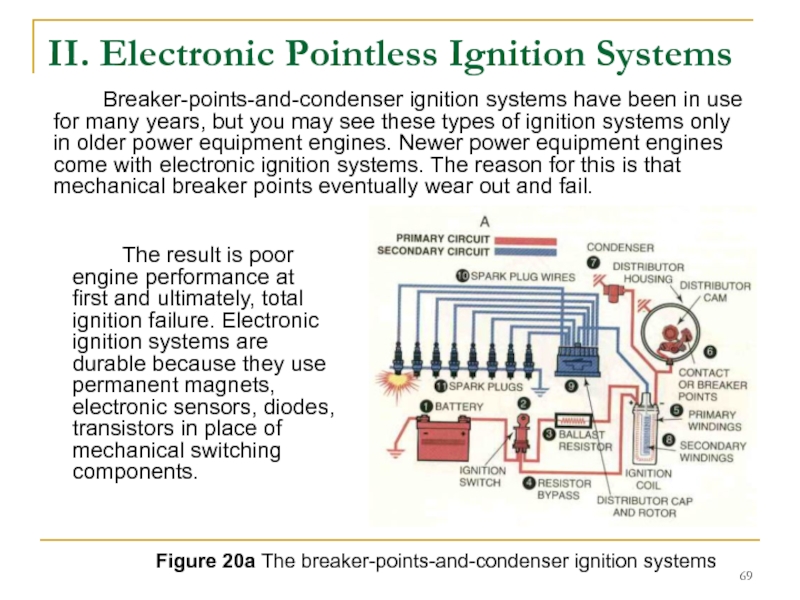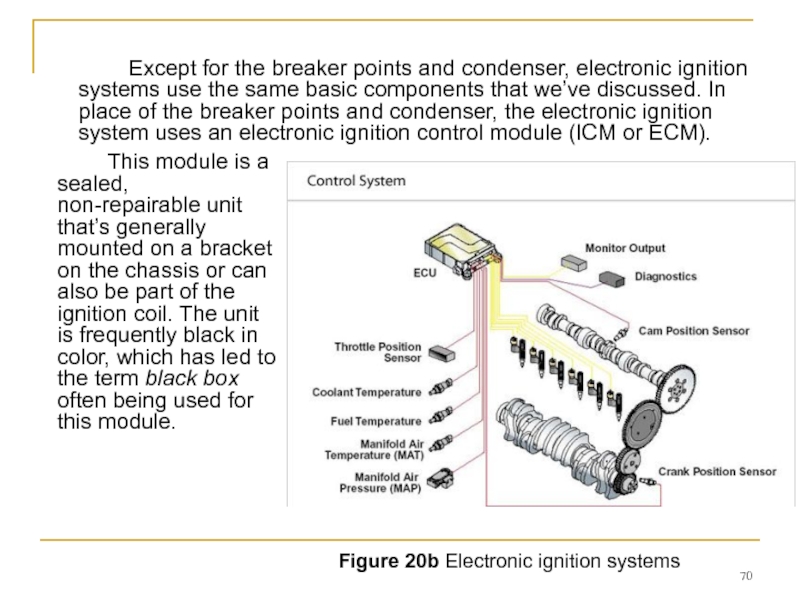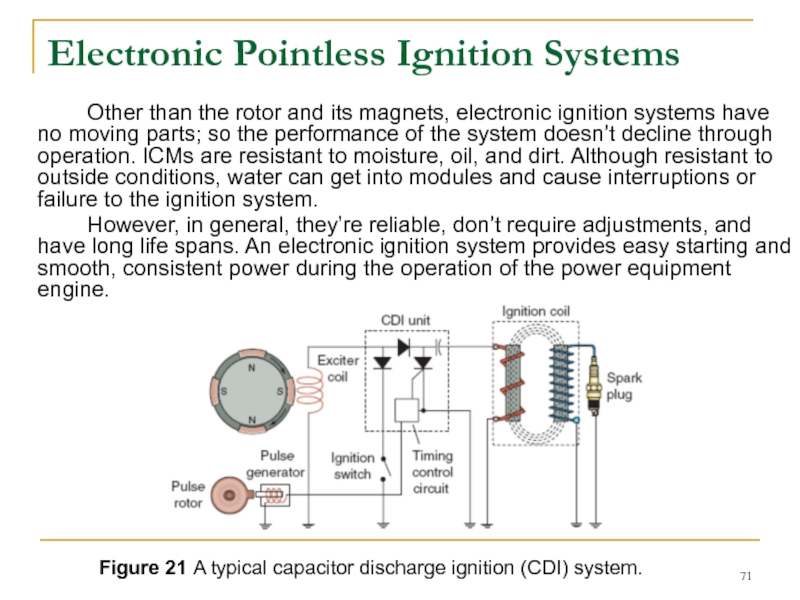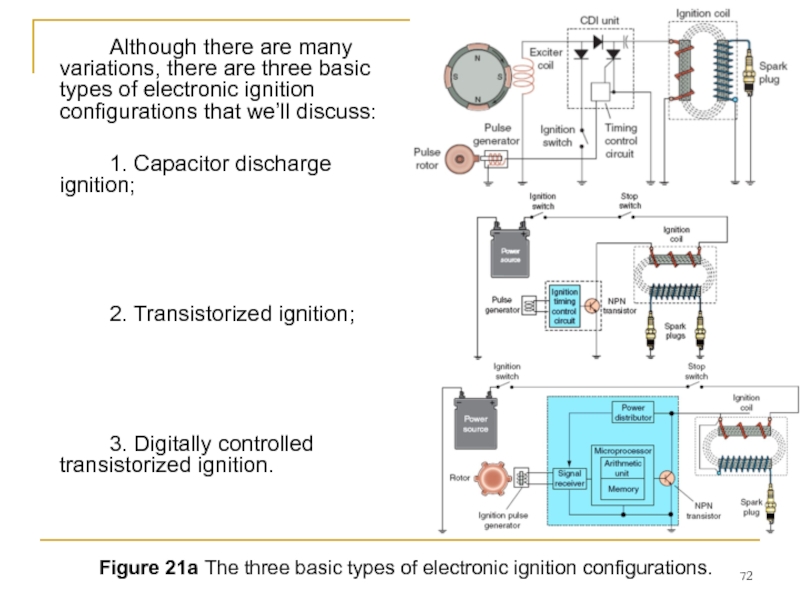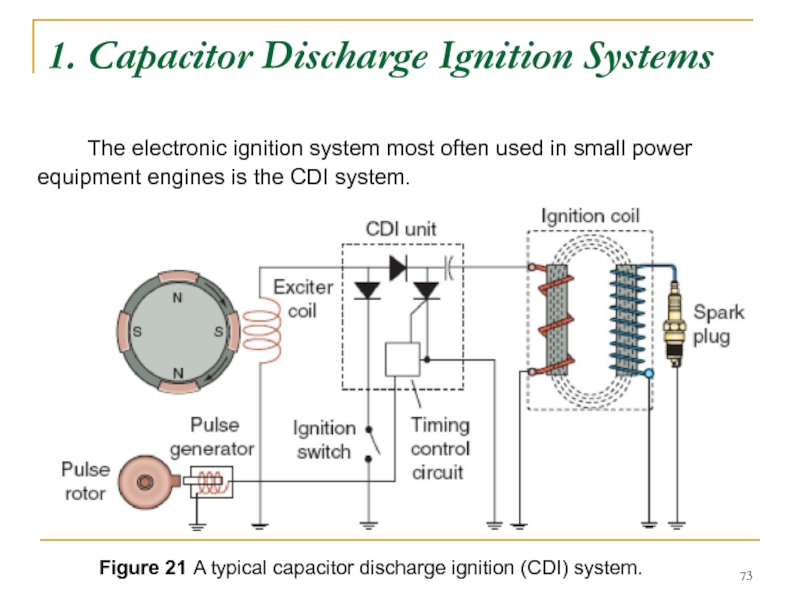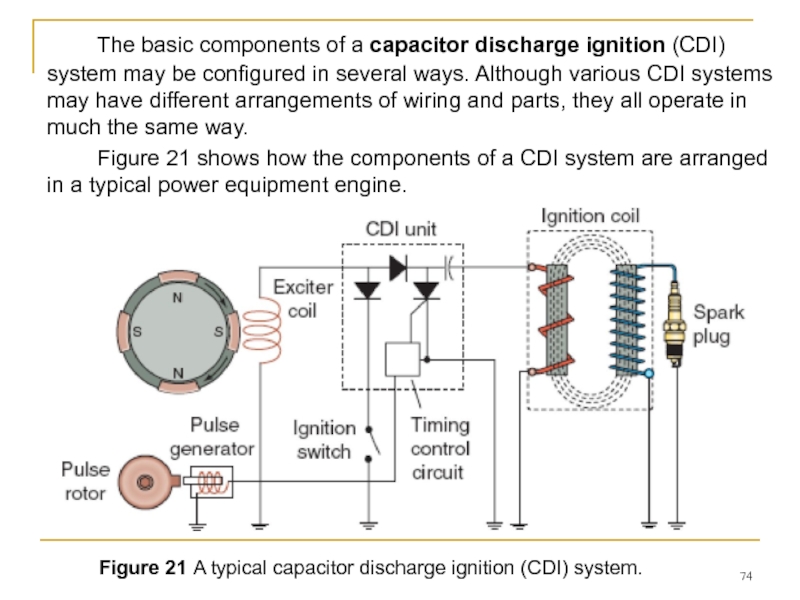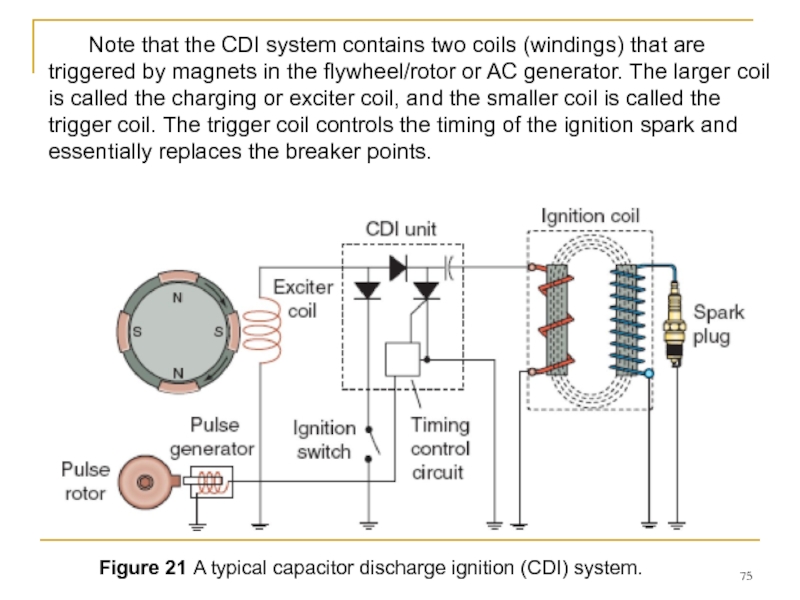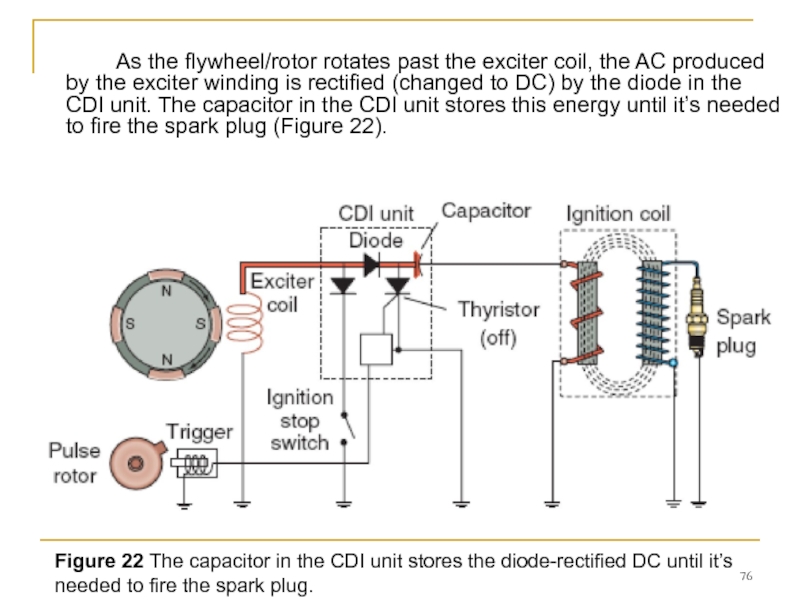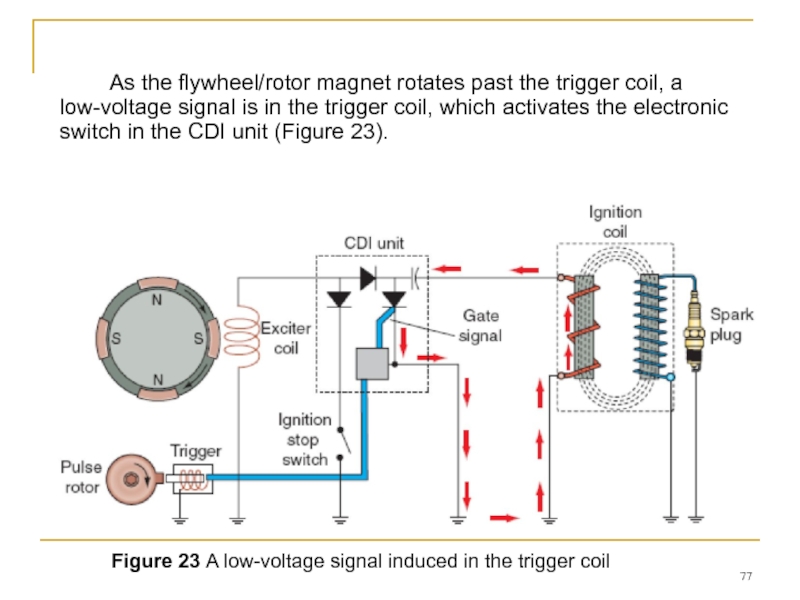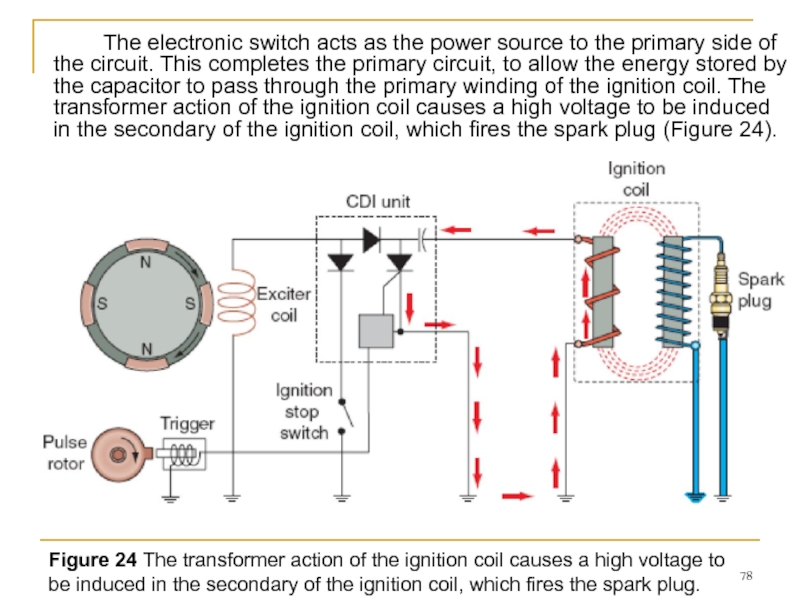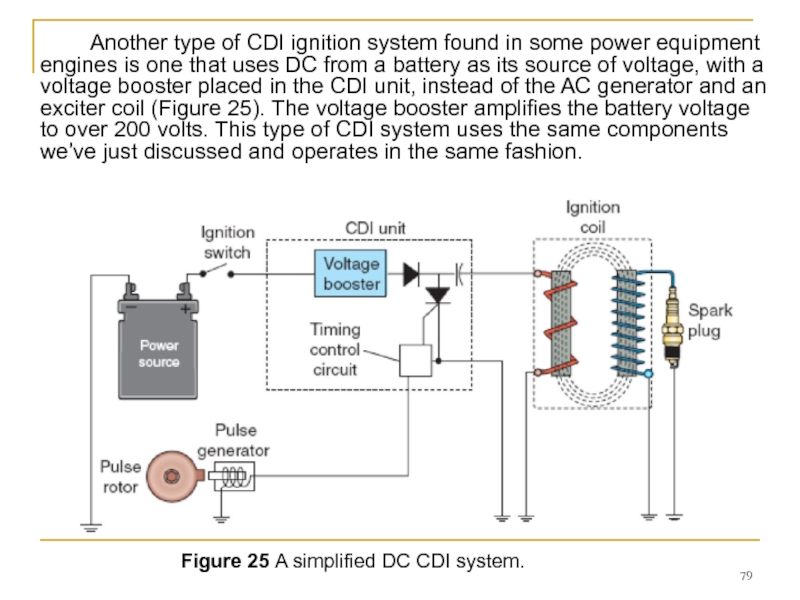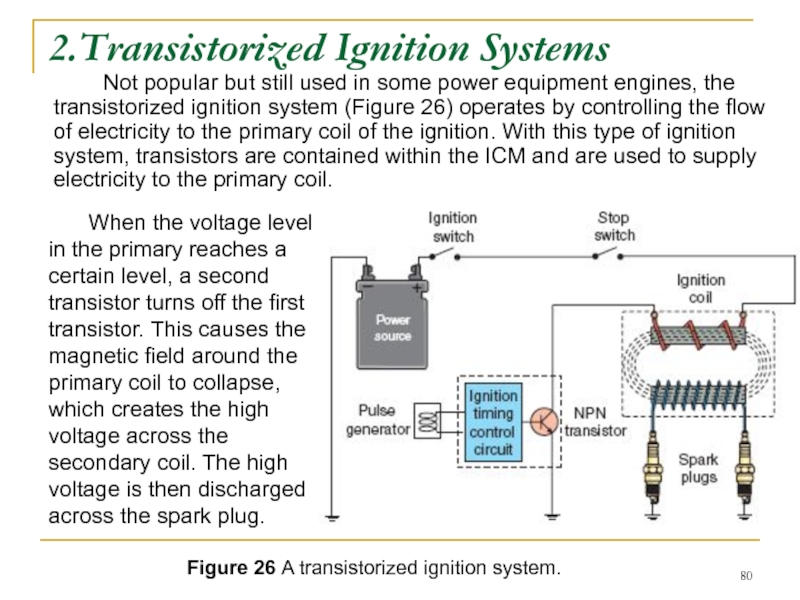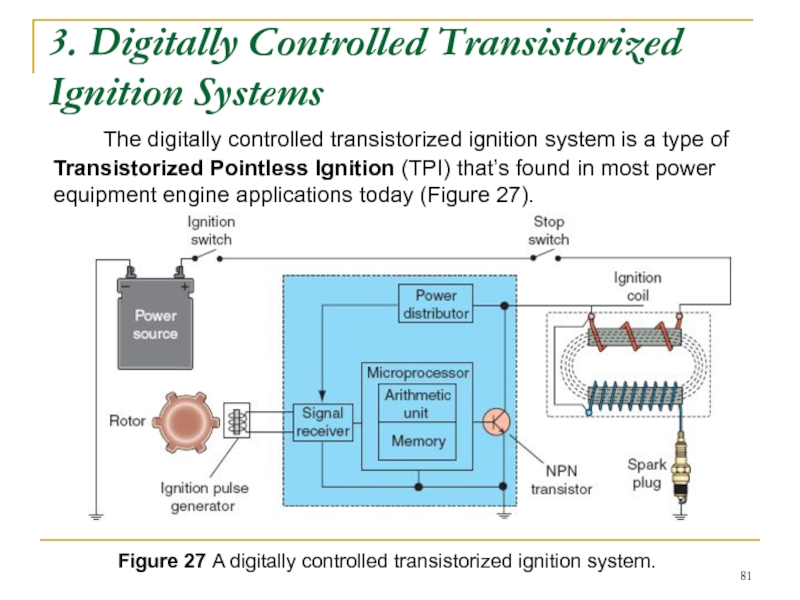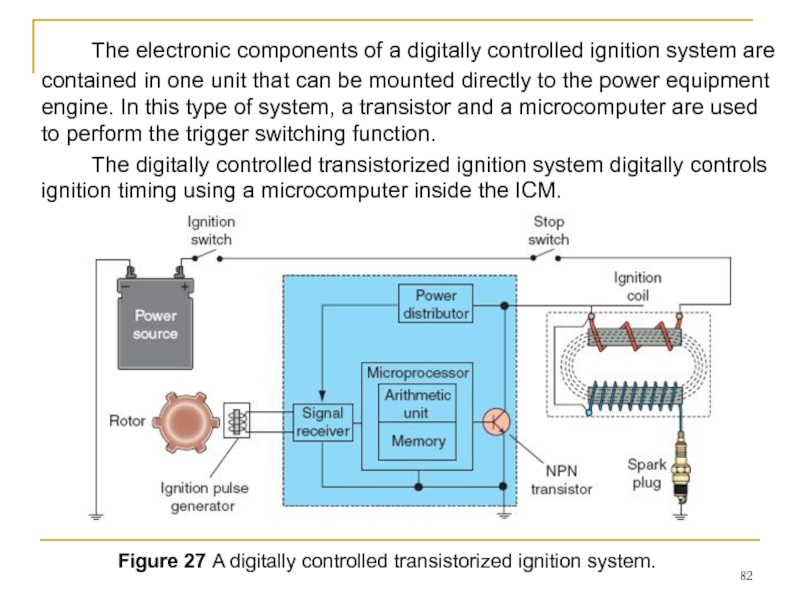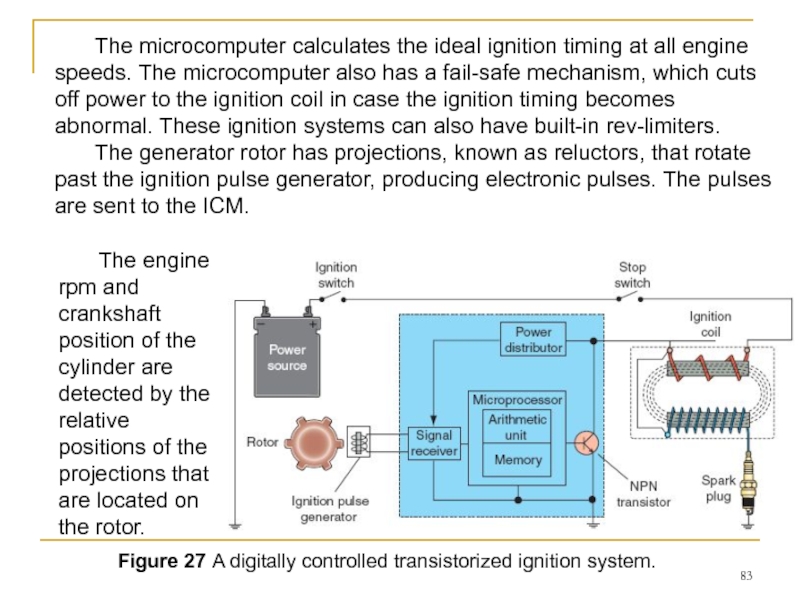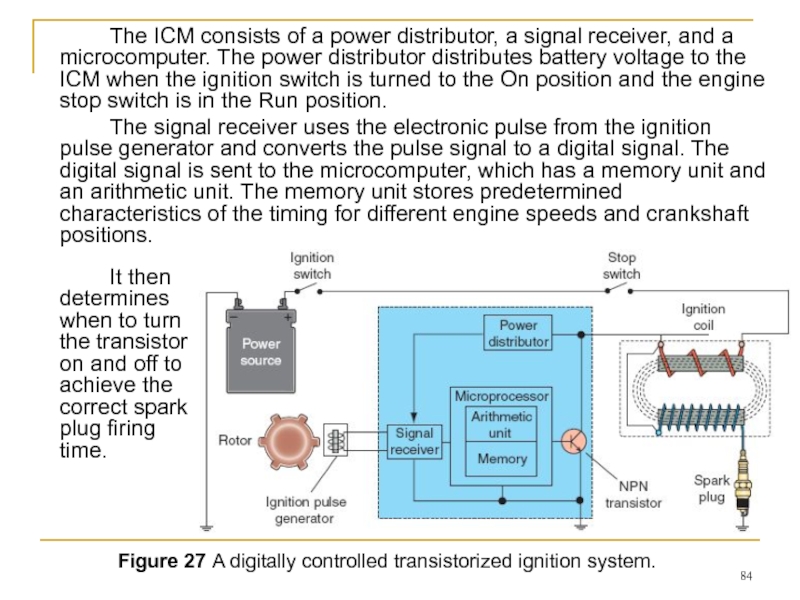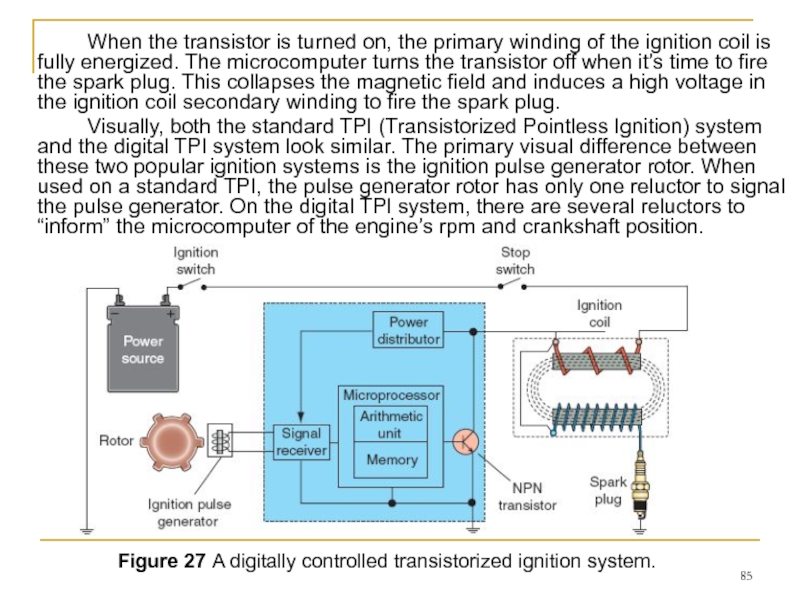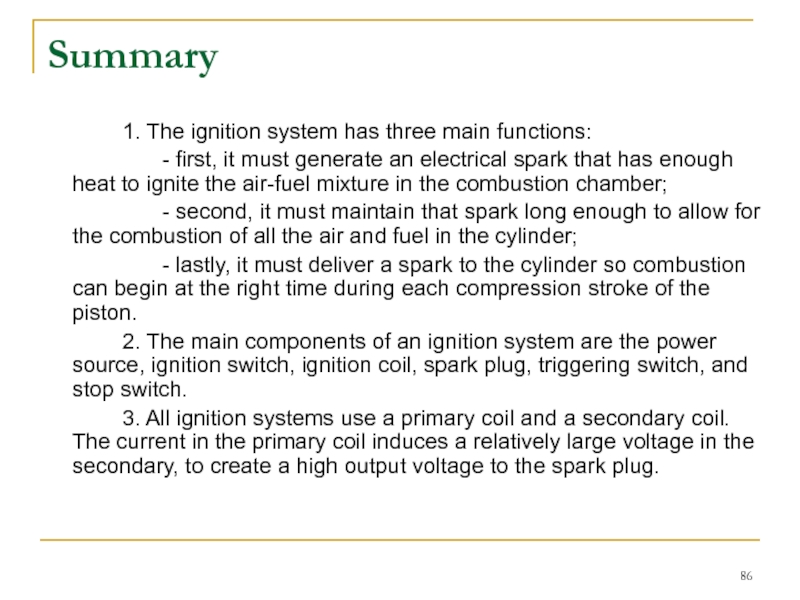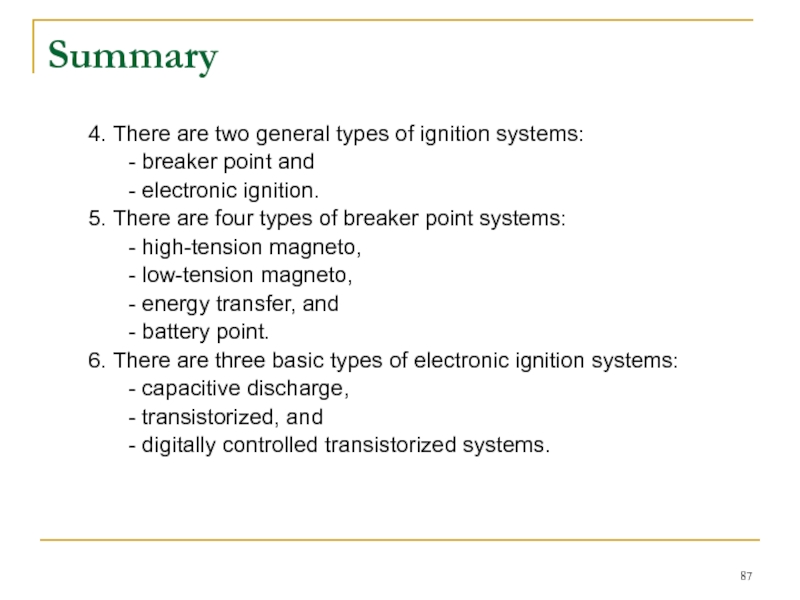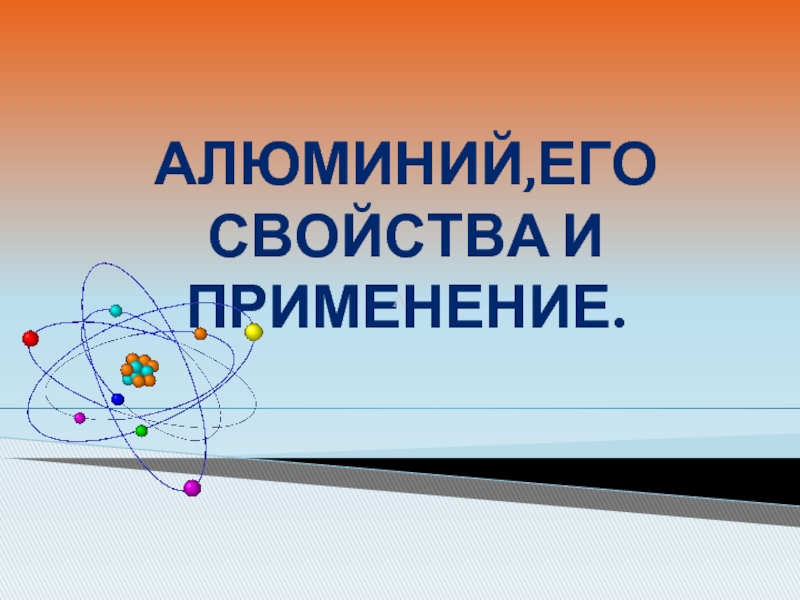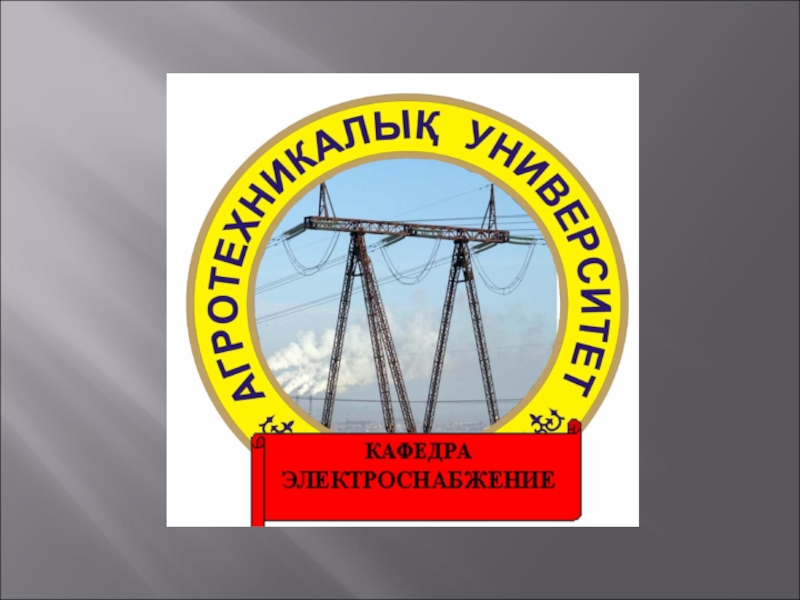- Главная
- Разное
- Дизайн
- Бизнес и предпринимательство
- Аналитика
- Образование
- Развлечения
- Красота и здоровье
- Финансы
- Государство
- Путешествия
- Спорт
- Недвижимость
- Армия
- Графика
- Культурология
- Еда и кулинария
- Лингвистика
- Английский язык
- Астрономия
- Алгебра
- Биология
- География
- Детские презентации
- Информатика
- История
- Литература
- Маркетинг
- Математика
- Медицина
- Менеджмент
- Музыка
- МХК
- Немецкий язык
- ОБЖ
- Обществознание
- Окружающий мир
- Педагогика
- Русский язык
- Технология
- Физика
- Философия
- Химия
- Шаблоны, картинки для презентаций
- Экология
- Экономика
- Юриспруденция
Internal сombustion engine. Ignition systems презентация
Содержание
- 1. Internal сombustion engine. Ignition systems
- 2. INTRODUCTION Do you remember the stages
- 3. One of the requirements for an efficient
- 4. POWER EQUIPMENT ENGINE IGNITION SYSTEMS The
- 5. Three main functions of the ignition system
- 6. For an engine to produce the maximum
- 7. Therefore, the delivery of the spark must
- 8. Figure 2 As an engine’s speed increases,
- 9. Figuring out when the spark should begin
- 10. Ignition Timing Ignition timing refers to the
- 11. When the marks are aligned at TDC,
- 12. Ignition Timing Advance Power equipment engines generally
- 13. Ignition systems in older power equipment engines
- 14. Electronic advance systems Most all modern day
- 15. Engine rpm and Turbulence At higher rpm,
- 16. Engine Load The load on an engine
- 17. Firing Order in Multi-Cylinder Engines Up
- 18. BASIC IGNITION SYSTEM COMPONENTS Figure 4
- 19. Power Sources In power equipment engine ignition
- 20. Power Sources Remember that when a conductor
- 21. Ignition Switch The ignition switch allows the
- 22. Ignition Coil An ignition coil is essentially
- 23. Ignition Coil In an ignition coil, one
- 24. Figure 5 A basic transformer. When
- 25. 20,000–60,000 volts If the current in
- 26. 20,000–60,000 volts Because the secondary winding of
- 27. Different Ignition systems The secondary winding of
- 28. Different Ignition systems In a collapsing-field ignition
- 29. Spark Plug The spark plug provides the
- 30. The insulator is made of ceramic materials
- 31. The terminal post on top of the
- 32. Spark Plug Reach One important design characteristic
- 33. If a plug’s reach is too short,
- 34. Heat Range When the engine is running,
- 35. The heat path for heat in the
- 36. Figure 8 Spark plug heat range: hot
- 37. Spark Plug Gap Correct spark plug air
- 38. Electrodes The materials used in the construction
- 39. Platinum has a much higher melting point
- 40. Until recently, platinum was considered the best
- 41. Electrode Designs Spark plugs are available with
- 42. The shape of the ground electrode may
- 43. Triggering Switch Devices Different types of ignition
- 44. Breaker Points and Condenser Breaker points
- 45. When the two breaker points touch, the
- 46. Figure 13 Shown is the action of
- 47. The spring mounted under the movable point
- 48. The condenser Another important component of a
- 49. Figure 14 A typical battery-powered breaker point
- 50. Electronic Trigger Devices When an electronic
- 51. Magnetic-Pulse Generator A magnetic pulse
- 52. Figure 15 A magnetic-pulse generator is located
- 53. Hall-Effect Sensor The Hall-effect sensor or switch
- 54. Hall-Effect Sensor Functionally, a Hall-effect switch performs
- 55. Stop Switch Different types of stop switches
- 56. TYPES OF IGNITION SYSTEMS Now that
- 57. I. Breaker point ignition system There are
- 58. (1)Magneto Ignition Systems In magneto ignition
- 59. High-Tension Magneto Ignition System High-tension magneto
- 60. With this ignition system, the ignition coil
- 61. Figure 16 A high-tension magneto system. The
- 62. Now, let’s take a closer look at
- 63. As the flywheel/rotor turns, the permanent magnets
- 64. The eccentric egg-shaped cam that is located
- 65. Low-Tension Magneto Ignition System The main difference
- 66. Energy-Transfer Ignition System The primary difference between
- 67. (2) Battery-and-Points Ignition Systems In a battery-and-points
- 68. As the points open, the primary magnetic
- 69. II. Electronic Pointless Ignition Systems Breaker-points-and-condenser
- 70. Except for the breaker points and condenser,
- 71. Electronic Pointless Ignition Systems Other than the
- 72. Although there are many variations, there are
- 73. 1. Capacitor Discharge Ignition Systems The
- 74. The basic components of a capacitor discharge
- 75. Figure 21 A typical capacitor discharge ignition
- 76. As the flywheel/rotor rotates past the exciter
- 77. As the flywheel/rotor magnet rotates past the
- 78. The electronic switch acts as the power
- 79. Another type of CDI ignition system found
- 80. 2.Transistorized Ignition Systems Not popular but still
- 81. 3. Digitally Controlled Transistorized Ignition Systems
- 82. The electronic components of a digitally controlled
- 83. Figure 27 A digitally controlled transistorized ignition
- 84. The ICM consists of a power distributor,
- 85. When the transistor is turned on, the
- 86. Summary 1. The ignition system has three
- 87. Summary 4. There are two general types
Слайд 2INTRODUCTION
Do you remember the stages of operation in a two-stroke and
In each cylinder of the engine, the piston rises during the compression stage to compress the air–fuel mixture in the combustion chamber. Just before the piston reaches the top-dead center (TDC), a spark plug fires in the cylinder and ignites the compressed air–fuel mixture. The ignition of the air–fuel mixture forces the piston down in the cylinder, producing the power stage.
The power produced by the ignition of the air–fuel mixture turns the crankshaft, which in turn keeps the piston moving and the engine running.
Слайд 3 One of the requirements for an efficient engine is the correct
Figure 1 The spark in combustion chamber
The ignition system must create a spark,
or current flow (Figure 1), across each pair of spark plug electrodes at the proper instant, under all engine operating conditions.
Слайд 4POWER EQUIPMENT ENGINE
IGNITION SYSTEMS
The sole purpose of an ignition system is
Слайд 5Three main functions of the ignition system
For each cylinder in
1. It must generate an electrical spark that has enough heat to ignite the air–fuel mixture in the combustion chamber;
2. It must maintain that spark long enough to allow for the combustion of all the air and fuel in the cylinder;
3. It must deliver a spark so that combustion can begin at the right time during each compression stroke of the piston.
Слайд 6 For an engine to produce the maximum amount of power it
The ignition advance
Слайд 7 Therefore, the delivery of the spark must be timed to arrive
The ignition advance
Слайд 8Figure 2 As an engine’s speed increases, a spark must be
However, at high speeds, as the engine has to provide more power to do more work, the high load on the crankshaft tends to slow down the acceleration of the piston, in which case the spark needs to be accordingly delayed.
Слайд 9 Figuring out when the spark should begin gets more complicated because
Factors of the combustion
How does an ignition system produce a spark, time it perfectly, and keep making sparks over and over again?
Let’s find out.
Слайд 10Ignition Timing
Ignition timing refers to the precise time spark occurs. It’s
Power equipment engine manufacturers specify initial or base ignition timing. Some engines don’t require such markings because the ignition systems are fixed in one position and are not adjustable.
Figure 2а Marks on crankshaft pulley and crankshaft sprocket.
Слайд 11 When the marks are aligned at TDC, the piston is at
Although most power equipment engines are designed to run over a relatively small engine rpm range (for instance, 600–6000 rpm), if optimum engine performance is to be maintained, the ignition timing of the engine must change as the operating conditions of the engine change.
Primary factors of ignition timing
These conditions affect the speed of the engine and the load on the engine. Therefore, all ignition timing changes are made in response to these primary factors.
Figure 2b Marks on crankshaft pulley and front cover of engine
Слайд 12Ignition Timing Advance
Power equipment engines generally run at relatively stable engine
Figure 3 The centrifugal advance mechanisms
Слайд 13 Ignition systems in older power equipment engines that require ignition timing
When engine speed increases, the weights move outward, shifting the plate where the triggering device is mounted.
This shifting of the plate causes the triggering device to receive its signal earlier, causing an advance in the ignition timing.
Figure 3 The centrifugal advance mechanisms
Ignition Timing Advance
Слайд 14Electronic advance systems
Most all modern day power equipment engines that require
The design eliminates the need for maintenance. Electronic advance systems use multiple sensors to determine the correct timing advancement for any given condition. They offer a greater variety of timing choices for different engine running conditions instead of basically only two, as is case with centrifugal advance systems.
Figure 3a The electronic advance system
Слайд 15Engine rpm and Turbulence
At higher rpm, the crankshaft turns through more
Another complication that arises at high rpm is the turbulence (swirling) of the air–fuel mixture, which increases with rpm. This causes the mixture inside the cylinder to turn faster. Increased turbulence requires that ignition must occur slightly later—or be slightly retarded—by the use of the advancer.
These two factors—high rpm and increased turbulence—must be balanced for optimum engine performance. Therefore, although ignition timing must be advanced as engine speed increases, the amount of advance must be decreased to compensate for the increased turbulence.
Слайд 16Engine Load
The load on an engine is related to the work
Under light loads and with the throttle partially open, a high vacuum exists in the intake manifold. The amount of air–fuel mixture drawn into the manifold and cylinders is small. On compression, this thin mixture produces less combustion pressure, and combustion time is increased. To complete combustion by the desired degrees ATDC, ignition timing must be advanced.
Under heavy loads, when the throttle is open fully, a larger mass of air–fuel mixture is drawn in, and the vacuum in the manifold is low. High combustion pressure and rapid burning result. In such cases, ignition timing must be retarded to prevent completion of burning before the crankshaft has reached the desired degrees ATDC.
Слайд 17Firing Order in Multi-Cylinder Engines
Up to this point, we’ve focused primarily
In the case of a multi-cylinder four-stroke engine, each cylinder of the engine must produce power once in every 720° of crankshaft rotation. Each cylinder must have a power stroke at its own appropriate time. To make this possible, the pistons and connecting rods are arranged in a precise fashion called the engine’s firing order.
The firing order is arranged to reduce rocking and imbalance problems. Because the potential for this rocking depends on the design and construction of the engine, the firing order varies from engine to engine. Engine manufacturers simplify cylinder identification by numbering each cylinder. Regardless of the firing order used, the No. 1 cylinder always starts the firing, with the rest of the cylinders following in a fixed sequence.
The ignition system must be able to “monitor” the rotation of the crankshaft and the relative position of each piston to determine which piston is on its compression stroke. It must also be able to deliver a high-voltage surge to each cylinder at the proper time during its compression stroke. How the ignition system does these things depends on the design of the system.
Слайд 18BASIC IGNITION SYSTEM
COMPONENTS
Figure 4 shows a simplified drawing of a basic
■ Power source
■ Ignition switch
■ Ignition coil
■ Spark plug
■ Triggering switch
■ Stop switch
All ignition systems contain these components. The difference is how the components function.
Figure 4 The basic components of an ignition system.
Слайд 19Power Sources
In power equipment engine ignition systems, there are just two
In a battery ignition system, a battery is connected to the ignition coil. A triggering switch device is used to alternately turn the DC voltage on and off for its operation.
AC generator power sources are far more common than battery systems for power equipment engines, and in most cases, they’re designed to be run without a battery. The AC-powered ignition system uses the principles of magnetism to produce a voltage.
Figure 4 The basic components of an ignition system.
Слайд 20Power Sources
Remember that when a conductor wire is moved through a
In an AC ignition system, permanent magnets are installed in the engine’s flywheel/rotor. As the flywheel/rotor turns, the moving magnets cause a voltage to be induced in the ignition coil.
Figure 4 The basic components of an ignition system.
Слайд 21Ignition Switch
The ignition switch allows the power source to provide electrical
Figure 4 The basic components of an ignition system.
Слайд 22Ignition Coil
An ignition coil is essentially a transformer that consists of
Figure 5 A basic transformer.
Слайд 23Ignition Coil
In an ignition coil, one end of the coil’s primary
Figure 5 A basic transformer.
Слайд 24Figure 5 A basic transformer.
When a voltage is applied to
Слайд 2520,000–60,000 volts
If the current in the primary winding is switched
Figure 5 A basic transformer.
When current passes through the primary winding of the coil, a magnetic field is created around the iron core. As the magnetic field expands, the magnetic lines of flux cut through the wires of the secondary winding and induce a voltage in the secondary winding.
Слайд 2620,000–60,000 volts
Because the secondary winding of the coil has many more
Figure 5 A basic transformer.
Слайд 27Different Ignition systems
The secondary winding of the coil is always connected
Figure 5 A basic transformer.
When the magnetic field in the ignition coil expands or collapses (coils are designed to do one or the other), the high voltage in the secondary is applied to the spark plug and causes a spark to jump across the spark plug gap. The spark ignites the air–fuel mixture, enabling the power equipment engine to run.
Слайд 28Different Ignition systems
In a collapsing-field ignition system, the high voltage from
In a rising-field ignition system, the high voltage from the secondary winding is used when the current to the primary winding is switched on. This means that all ignition systems need some type of a device that will keep turning the current from the power source on and off.
Figure 5 A basic transformer.
It’s important to remember that the high voltage in the secondary winding of the coil is produced each time the primary current is turned on or off.
Слайд 29Spark Plug
The spark plug provides the crucial air gap across which
The main parts of a spark plug are
- a steel shell;
- a ceramic core or insulator, which acts as a heat conductor; and
- a pair of electrodes, one insulated in the core and the other grounded on the shell.
The shell holds the ceramic core and electrodes in a gastight assembly and has threads for plug installation in the engine (Figure 6).
Figure 6 The parts of a typical spark plug.
Слайд 30 The insulator is made of ceramic materials to provide for increased
The parts of a typical spark plug
Some spark plugs use a semiconductor material to provide for this resistance.
The resistor reduces radio frequency interference (RFI), which can interfere with, or damage, radios, computers, and other electronic accessories.
Figure 6 The parts of a typical spark plug.
Слайд 31 The terminal post on top of the center electrode is the
Figure 6 The parts of a typical spark plug.
The parts of a typical spark plug
These seals prevent combustion gases from leaking out of the cylinder. Ribs on the insulator increase the distance between the terminal and the shell, to help prevent electric arcing on the outside of the insulator. The steel spark plug shell is crimped over the insulation, and a ground electrode, on the lower end of the shell, is positioned directly below the center electrode. There is an air gap between these two electrodes.
Spark plugs come in many sizes and designs to accommodate different engine designs.
Слайд 32Spark Plug Reach
One important design characteristic of spark plugs is spark
Figure 7 Spark plug reach
Слайд 33 If a plug’s reach is too short, its electrodes are in
Figure 7 Spark plug reach
Preignition is a term used to describe abnormal combustion, which is caused by something other than the heat of the spark. Spark plug reach is crucial because the plug’s air gap must be properly placed in the combustion chamber to produce the correct amount of heat.
Abnormal combustion
Слайд 34Heat Range
When the engine is running, most of the spark plug’s
In liquid-cooled engines, coolant circulating in the head absorbs the heat and moves it through the cooling system.
In air-cooled engines, the heat is absorbed through the cylinder head.
Figure 8 Spark plug heat range: hot versus cold.
Слайд 35 The heat path for heat in the center electrode is through
In a cold spark plug (Cold Plug), there is a short distance for the heat to travel up the insulator to the shell. This short path for heat means the electrode and insulator maintain little heat between firings.
Heat Range
Слайд 36Figure 8 Spark plug heat range: hot versus cold.
In a hot
The heat range is indicated by a code imprinted on the side of the spark plug, usually on the porcelain insulator.
Heat Range
Слайд 37Spark Plug Gap
Correct spark plug air gap (Figure 9) is essential
If the required voltage is greater than what is available, misfiring results. Misfiring occurs because of the inability of voltage generated at the secondary coils to jump the gap or maintain the spark. Alternatively, a gap that is too narrow requires lower voltages and can lead to rough idle and prematurely burned electrodes, due to higher current flow. Also, a misfire may occur if a spark plug terminal is loose.
Figure 9 Spark plug gaps.
Слайд 38Electrodes
The materials used in the construction of a spark plug’s electrodes
The electrodes of a standard spark plug are made out of copper, and some use a copper–nickel alloy. Copper is a good electrical conductor and offers resistance to corrosion.
Platinum electrodes are used to extend the life of a spark plug (Figure 10).
Figure 10 A platinum-tipped spark plug.
Слайд 39 Platinum has a much higher melting point than copper and is
Platinum alloy spark plugs
Spark plugs are available with only the center electrode made of platinum (called single-platinum) and with the center and ground electrodes made of platinum (called double-platinum). Some platinum plugs have a very small center electrode combined with a sharp-pointed ground electrode designed for better performance.
Figure 10 A platinum-tipped spark plug.
Слайд 40 Until recently, platinum was considered the best material to use for
Iridium alloy spark plugs
Figure 11 This spark plug has a small-diameter iridium center electrode and a grooved ground electrode.
A few spark plugs use an iridium alloy as the primary metal complemented by rhodium to increase oxidation wear resistance. This iridium alloy is so durable that it allows for an extremely small center electrode. A typical copper–nickel plug has a 2.5-mm-diameter center electrode, whereas a platinum plug has a diameter of 1.1 mm. An iridium plug can have a diameter as small as 0.4 mm (Figure 11), which means firing voltage requirements are decreased. Iridium is also used as an alloying material for platinum.
Слайд 41Electrode Designs
Spark plugs are available with many shapes and numbers of
Figure 11а Electrode designs.
Слайд 42 The shape of the ground electrode may also be altered. A
Electrode Designs
Ground electrodes in many power equipment engine spark plugs have a U-groove machined into the side that faces the center electrode. The U-groove allows the flame front to fill the gap formed by the U-shape. This ball of fire develops a larger and hotter flame front, leading to a more complete combustion.
Figure 11b U-groove ground electrode.
Слайд 43Triggering Switch Devices
Different types of ignition systems use different types of
1. Older ignition systems use a set of electrical contacts called breaker points and a condenser to do the switching. Although rarely used by any major manufacturer today, breaker points and condensers continue to be in use in millions of older power equipment engines.
2. All modern power equipment engine systems, however, use electronic components to do the switching.
In either system, the construction of the ignition coil and the spark plug remain the same.
Figure 11c A basic transformer and digitally controlled transistorized ignition system
Слайд 44Breaker Points and Condenser
Breaker points are mechanical contacts that are used
One breaker point is stationary (fixed), and the other point is movable and insulated from the stationary point. The movable contact is mounted on a spring-loaded arm, which holds the points together.
Figure 12 shows a simplified drawing of a set of breaker points.
Figure 12 A set of breaker points.
Слайд 45 When the two breaker points touch, the ignition circuit is complete
Breaker Points and Condenser
Figure 13 Shown is the action of breaker points in a simple ignition circuit.
Слайд 46Figure 13 Shown is the action of breaker points in a
When the breaker points are closed, current flows through the ignition coil’s primary winding. When the points open, the circuit is broken, and the magnetic field in the coil collapses, which induces a voltage into the coil secondary to fire the spark plug.
Слайд 47 The spring mounted under the movable point holds the movable breaker
Breaker Points and Condenser
Figure 12 A set of breaker points.
Слайд 48The condenser
Another important component of a breakerpoints system is the condenser
Figure 14 A typical battery-powered breaker point system.
Unless this current flow is controlled in some way, a spark or arc will occur across the breaker points as they move apart. If this sparking is allowed to occur, the breaker points will arc, burn, and fail to operate properly. The points would also absorb the electrical energy and reduce the output voltage of the ignition coil.
Слайд 49Figure 14 A typical battery-powered breaker point system.
For these reasons, a
The breaker-points-and-condenser switching system can be used in both AC and battery powered ignition systems.
Figure 14 shows a breaker-points system. Note the location of the breaker points and condenser in the circuit.
Слайд 50Electronic Trigger Devices
When an electronic ignition system is used in a
These sensors primarily include:
- magnetic-pulse generators and
- Hall-effect sensors.
An electronic switch completely eliminates the need for breaker points and a condenser.
Слайд 51 Magnetic-Pulse Generator
A magnetic pulse generator is located generally on the
- a timing disc (also known as a reluctor) and
- a pickup coil (Figure 15).
Figure 15 A magnetic-pulse generator is located near the engine’s crankshaft or camshaft in most cases.
Слайд 52Figure 15 A magnetic-pulse generator is located near the engine’s crankshaft
The pickup coil consists of a length of wire wrapped around a permanent magnet. The magnetic-pulse generator operates on the basic electromagnetic principle that voltage can be induced only when a conductor moves through a magnetic field. When the crankshaft or camshaft is turned, the timing disc moves through the magnetic field.
As the timing disc teeth approach the pickup coil, a voltage is induced, and this is used to control the voltage to the primary side of the ignition coil, just as the opening and closing of the contact points in the breaker-points-and-condenser switching system. A specific,
manufacturer-determined air gap is required to ensure that a signal of appropriate strength is being produced.
Слайд 53Hall-Effect Sensor
The Hall-effect sensor or switch is the most commonly used
Furthermore, a Hall-effect switch produces a square-wave pattern that is more compatible with the digital signals required by onboard computers.
Figure 15a The Hall-effect sensor
Слайд 54Hall-Effect Sensor
Functionally, a Hall-effect switch performs the same tasks as a
Figure 15b The Hall-effect principle
Слайд 55Stop Switch
Different types of stop switches are found in different types
In other engines, the stop switch is designed to prevent the flow of electricity through the primary winding of the ignition coil. This type of stop switch is connected in series with the primary side of the ignition coil. When you turn the switch to the Off position, the ignition circuit is made to open and the engine stops.
Once an engine is started, it will keep running until it runs out of fuel or is put under a heavy-enough load to cause it to stall. The stop switch provides a convenient means to stop the engine.
Figure 4 The basic components of an ignition system.
Слайд 56TYPES OF IGNITION SYSTEMS
Now that you understand how a basic ignition
I. Breaker point ignition system
II. Electronic ignition system
Figure 15c A breaker point ignition and electronic ignition systems
Слайд 57I. Breaker point ignition system
There are two types of breaker point
(1) The magneto breaker point ignition system is usually found in older machines, where a voltage is needed only to power the spark plug—not a starter system or lights.
(2) The battery-and-points ignition system is found in most of the older power equipment engines that have electric starter systems and lights.
Figure 15d A high-tension magneto system and battery-and-points ignition system
Слайд 58(1)Magneto Ignition Systems
In magneto ignition systems in older power equipment engines
Figure 16 A high-tension magneto system
The magneto ignition system uses permanent magnets installed on the engine’s flywheel/rotor. Magnetos are classified as being one of three types:
■ High tension
■ Low tension
■ Energy transfer
Слайд 59High-Tension Magneto Ignition System
High-tension magneto ignition systems (Figure 16) haven’t been
Figure 16 A high-tension magneto system.
Слайд 60 With this ignition system, the ignition coil (magneto primary and secondary
Figure 16 A high-tension magneto system.
The position of the magnets on the flywheel/rotor is important. To generate the voltage at the exact time needed, the magnets in the flywheel/rotor must be properly aligned. This means that the flywheel/rotor must be located exactly in the position required on the crankshaft.
Слайд 61Figure 16 A high-tension magneto system.
The gap between the edge of
magneto ignition system.
Слайд 62 Now, let’s take a closer look at the operation of a
Remember that the ignition coil is basically a transformer and contains a primary winding and a secondary winding. In a typical hightension magneto ignition coil, the primary winding comprises about 150 turns of fairly heavy copper wire, and the secondary winding comprises about 20,000 turns of very fine copper wire. This difference in the windings is what causes the voltage to be multiplied as it’s induced by the primary to the secondary.
Figure 17 A high-tension magneto ignition system.
Слайд 63 As the flywheel/rotor turns, the permanent magnets mounted near the edge
This is when the condenser comes in handy. The primary winding, as can be seen in Figure 17, is connected to the breaker points. When the breaker points are closed, a complete circuit is formed, and a current flows through the primary winding to produce a magnetic field.
Figure 17 A high-tension magneto ignition system.
Слайд 64 The eccentric egg-shaped cam that is located on the crankshaft is
The high voltage induced in the secondary winding causes a current to flow through the spark plug wire and arc across the spark plug gap. After the high voltage in the secondary winding is released as a spark, the flywheel/rotor continues to turn until the magnet positions itself by the ignition coil again, and the process repeats itself.
Figure 17 A high-tension magneto ignition system.
Слайд 65Low-Tension Magneto Ignition System
The main difference is that the low-tension system
Figure 18 A low-tension magneto ignition system.
Not found often in power equipment engines, the low-tension magneto system is similar in operation to the high-tension magneto system.
Слайд 66Energy-Transfer Ignition System
The primary difference between the energy-transfer system and the
The energy-transfer ignition system (Figure 19) is another type of magneto ignition system found in power equipment engines.
Figure 19 An energy-transfer ignition system.
Слайд 67(2) Battery-and-Points Ignition Systems
In a battery-and-points ignition system, a battery is
The battery used in this type of system is the lead acid storage battery. Besides providing electricity to power the ignition coil, the battery may also be used to power lights, electric starter systems, and other accessories.
Figure 20 The battery-and-points system
Now, let’s look at a battery-and-points ignition system. Remember that battery ignition systems were used in older street-type power equipment engines.
Слайд 68 As the points open, the primary magnetic field rapidly collapses, causing
When the ignition switch is turned off, the switch contacts open, and the flow of power from the battery to the primary winding of the ignition coil is stopped. As a result, the engine stops running.
Figure 20 The battery-and-points system
The breaker points, the secondary winding, and the spark plug operate in exactly the same manner as in the high- and low-tension magneto systems. The contact points are opened by the breaker-point cam at the specified time.
Слайд 69II. Electronic Pointless Ignition Systems
Breaker-points-and-condenser ignition systems have been in use
The result is poor engine performance at first and ultimately, total ignition failure. Electronic ignition systems are durable because they use permanent magnets, electronic sensors, diodes, transistors in place of mechanical switching components.
Figure 20a The breaker-points-and-condenser ignition systems
Слайд 70 Except for the breaker points and condenser, electronic ignition systems use
This module is a sealed, non-repairable unit that’s generally mounted on a bracket on the chassis or can also be part of the ignition coil. The unit is frequently black in color, which has led to the term black box often being used for this module.
Figure 20b Electronic ignition systems
Слайд 71Electronic Pointless Ignition Systems
Other than the rotor and its magnets, electronic
However, in general, they’re reliable, don’t require adjustments, and have long life spans. An electronic ignition system provides easy starting and smooth, consistent power during the operation of the power equipment engine.
Figure 21 A typical capacitor discharge ignition (CDI) system.
Слайд 72 Although there are many variations, there are three basic types of
1. Capacitor discharge ignition;
2. Transistorized ignition;
3. Digitally controlled transistorized ignition.
Figure 21a The three basic types of electronic ignition configurations.
Слайд 731. Capacitor Discharge Ignition Systems
The electronic ignition system most often used
Figure 21 A typical capacitor discharge ignition (CDI) system.
Слайд 74 The basic components of a capacitor discharge ignition (CDI) system may
Figure 21 shows how the components of a CDI system are arranged in a typical power equipment engine.
Figure 21 A typical capacitor discharge ignition (CDI) system.
Слайд 75Figure 21 A typical capacitor discharge ignition (CDI) system.
Note that the
Слайд 76 As the flywheel/rotor rotates past the exciter coil, the AC produced
Figure 22 The capacitor in the CDI unit stores the diode-rectified DC until it’s needed to fire the spark plug.
Слайд 77 As the flywheel/rotor magnet rotates past the trigger coil, a low-voltage
Figure 23 A low-voltage signal induced in the trigger coil
Слайд 78 The electronic switch acts as the power source to the primary
Figure 24 The transformer action of the ignition coil causes a high voltage to be induced in the secondary of the ignition coil, which fires the spark plug.
Слайд 79 Another type of CDI ignition system found in some power equipment
Figure 25 A simplified DC CDI system.
Слайд 802.Transistorized Ignition Systems
Not popular but still used in some power equipment
When the voltage level in the primary reaches a certain level, a second transistor turns off the first transistor. This causes the magnetic field around the primary coil to collapse, which creates the high voltage across the secondary coil. The high voltage is then discharged across the spark plug.
Figure 26 A transistorized ignition system.
Слайд 813. Digitally Controlled Transistorized Ignition Systems
The digitally controlled transistorized ignition system
Figure 27 A digitally controlled transistorized ignition system.
Слайд 82 The electronic components of a digitally controlled ignition system are contained
The digitally controlled transistorized ignition system digitally controls ignition timing using a microcomputer inside the ICM.
Figure 27 A digitally controlled transistorized ignition system.
Слайд 83Figure 27 A digitally controlled transistorized ignition system.
The microcomputer calculates the
The generator rotor has projections, known as reluctors, that rotate past the ignition pulse generator, producing electronic pulses. The pulses are sent to the ICM.
The engine rpm and crankshaft position of the cylinder are detected by the relative positions of the projections that are located on the rotor.
Слайд 84 The ICM consists of a power distributor, a signal receiver, and
The signal receiver uses the electronic pulse from the ignition pulse generator and converts the pulse signal to a digital signal. The digital signal is sent to the microcomputer, which has a memory unit and an arithmetic unit. The memory unit stores predetermined characteristics of the timing for different engine speeds and crankshaft positions.
Figure 27 A digitally controlled transistorized ignition system.
It then determines when to turn the transistor on and off to achieve the correct spark plug firing time.
Слайд 85 When the transistor is turned on, the primary winding of the
Visually, both the standard TPI (Transistorized Pointless Ignition) system and the digital TPI system look similar. The primary visual difference between these two popular ignition systems is the ignition pulse generator rotor. When used on a standard TPI, the pulse generator rotor has only one reluctor to signal the pulse generator. On the digital TPI system, there are several reluctors to “inform” the microcomputer of the engine’s rpm and crankshaft position.
Figure 27 A digitally controlled transistorized ignition system.
Слайд 86Summary
1. The ignition system has three main functions:
- first, it must
- second, it must maintain that spark long enough to allow for the combustion of all the air and fuel in the cylinder;
- lastly, it must deliver a spark to the cylinder so combustion can begin at the right time during each compression stroke of the piston.
2. The main components of an ignition system are the power source, ignition switch, ignition coil, spark plug, triggering switch, and stop switch.
3. All ignition systems use a primary coil and a secondary coil. The current in the primary coil induces a relatively large voltage in the secondary, to create a high output voltage to the spark plug.
Слайд 87Summary
4. There are two general types of ignition systems:
- breaker
- electronic ignition.
5. There are four types of breaker point systems:
- high-tension magneto,
- low-tension magneto,
- energy transfer, and
- battery point.
6. There are three basic types of electronic ignition systems:
- capacitive discharge,
- transistorized, and
- digitally controlled transistorized systems.
